




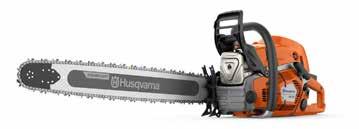

90cc worth of unparalleled power in an easily manoeuvred and lightweight package. An X-Torq® engine with outstanding torque and acceleration and, to top it off, a razor-sharp X-CUT® chain perfectly in tune with your saw. The end result is best in class cutting capacity, making you better, faster, providing you with unparalleled levels of productivity. In short, a better cutting experience. Scan the QR code to read more about new Husqvarna 592 XP®, cutting capacity tests and register your interest in the lead up to the launch in Australia, at husqvarna.com/90cc
The Christmas/New year holiday often yields a lean period extending into the New Year, this is true of arboricultural business and for us here at The Australian Arbor Age this edition. We have been a bit down on input for the first publication of 2022 – not least from myself, having gotten very sick over the holiday period (I drank contaminated water).
Nonetheless we have three Technical Features, one from Guy Meilleur, one from myself and one from Jim McArdle from TCAA and Hephzibah Crossing, as well as an Industry People story on Mona Bruckhoff and another feature by Peter Dubiez in the series on R U OK.
Guy’s international review of industry works and standards continues in his latest article – Consistent Cutting: Continuing the Quest. This is a comparative study of the new draft European Tree Pruning Standard (ETPS) against existing standards. As ever Guy expands our minds on the world of people and trees (impressive to see cut size specifications influencing permission to use chainsaws). This article shines light for the next Australian Standard upgrade. Coming to my contribution, though I gathered my foundation data (with the High
Climbers Brotherhood), I had to defer an issue for writing Part 2 of this new series on ancient Fig trees because of my recovery. However, being on the verge of a significant opportunity with a past 2019 report turned AA article – Tree Care and The Ecovillage Movement I am re-running Part 1 as I now have Part 2 in my sights – this is an exciting Conservation Arboriculture project. The Ecovillage movement is an interesting study, with the capacity to unite top end
Horticulture, Arboriculture and Resilience Farming with Permaculture, Bio Dynamic and Syntropic farming in that equation. The same key elements link us together, understanding of the nutrient cycles, fungi activated soils, biological input (humus) and plant care. With consideration of the Industry Profile on Mona Bruckhoff I enjoyed being reminded of fresh QAA input and the drive for Conservation in arboriculture in others who see the same light. Personally, I encourage all that see conservation as an essential catalyst for needed change. Sustainability involves sensitive environmental practises as well as economics.
Peter Dubiez runs another feature R U OK – A Conservation Could Change a Life, this feature is based on an interview with Advanced Tree Works owner Owen Hardy. We wish you well moving into 2022 and look forward to more feature articles coming in from Australian arboriculture. If you feel you have some good input remember my call for feature articles in 2021. We are always open to receiving work from scientific minds and solid contractors, many of you have both.

Cheers, Cassian Humphreys, AA Sub Editor AA
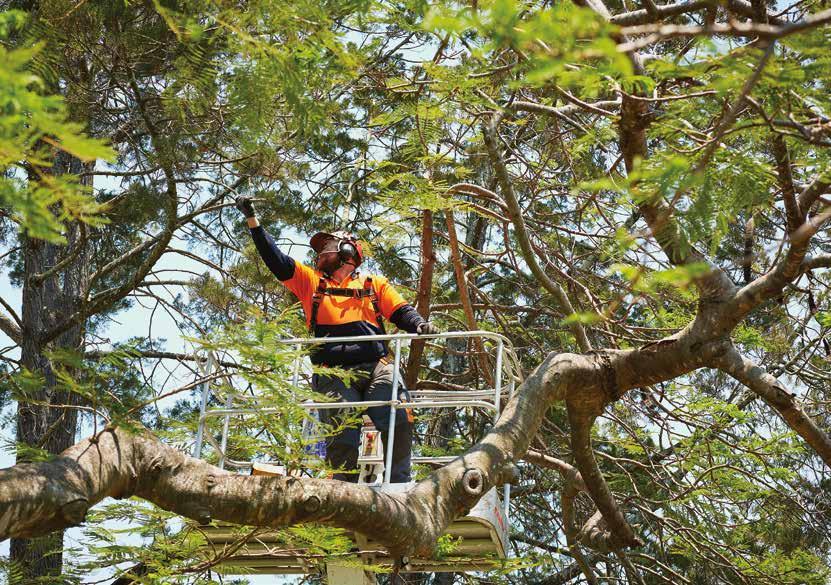
Publisher
Kurt M. Quambusch
Contributing Editor
Tom Foster tom@maynemedia.com.au
Production Manager
Arianna Lucini arianna@maynemedia.com.au
Group Sales Manager KahChi Liew kahchi@maynemedia.com.au 1300 764 688
National Advertising Manager Sineade Sullivan sineade@maynemedia.com.au
Arlette Kouchakdjian (02) 8355 6841 / (02) 9452 4517 arlette@maynemedia.com.au
Design Peter Cartledge art@maynemedia.com.au
ISSN 1327 1784
The Australian Arbor Age and Forestry is a Bi-Monthly magazine published by Mayne Media Group Pty Ltd.

ACN 130 678 812 ABN 27 130 678 812 Postal: PO Box 489 DEE WHY NSW 2099 Australia Ph: 1300 76 4688 Int Ph: + 612 9452 4517 Int Fax: + 612 9452 5319 www.arborage.com.au
Copyright 2022
Mayne Media Group Pty Ltd. Material may not be reproduced or photocopied in any form without the written permission of the publisher. Mayne Media Group Pty Ltd. believes that all material is correct at the time of printing and will not be held liable for any incorrect information supplied within.
Cassian is a Merrist-woodian graduate (NCH-arb - 1991) qualified to Diploma level in Australia (09), his career commenced in Horticulture (85) and transitioned into Arboriculture (89). An experienced tree climber, instructor, arboriculturist, consultant, educator and writer, he has 30 years of experience. He sees his work as making a contribution to the Australian arboricultural profession.





Guy is a Master Arborist and Utility and Municipal Specialist, facilitating the co-existence of trees and people for the past 46 years. His company HistoricTreeCare.com manages the risk in veteran and historic trees by installing lightning and support systems, root invigoration, pruning and community education. Guy writes for tree care publications and works with the ANSI A300 Tree Care Standards committee in the US. He studies the science of arboriculture around the world.
Peter is the CEO of Sydneybased Enviro Frontier (EF). EF utilises over 250 Tree Companies across Australia in managing tree works on behalf of its clients in the Insurance, Government and Facilities Management sectors. All jobs are managed using its proprietary technology platform (TreeManager) making it the leading data provider for the insurance and facility management industry. The company also operates in NZ, UK and Spain.
For almost 45 years Graeme has been based in the Dandenong Ranges East of Melbourne and become world leader in large tree removals.

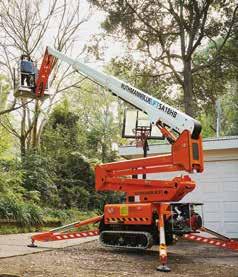


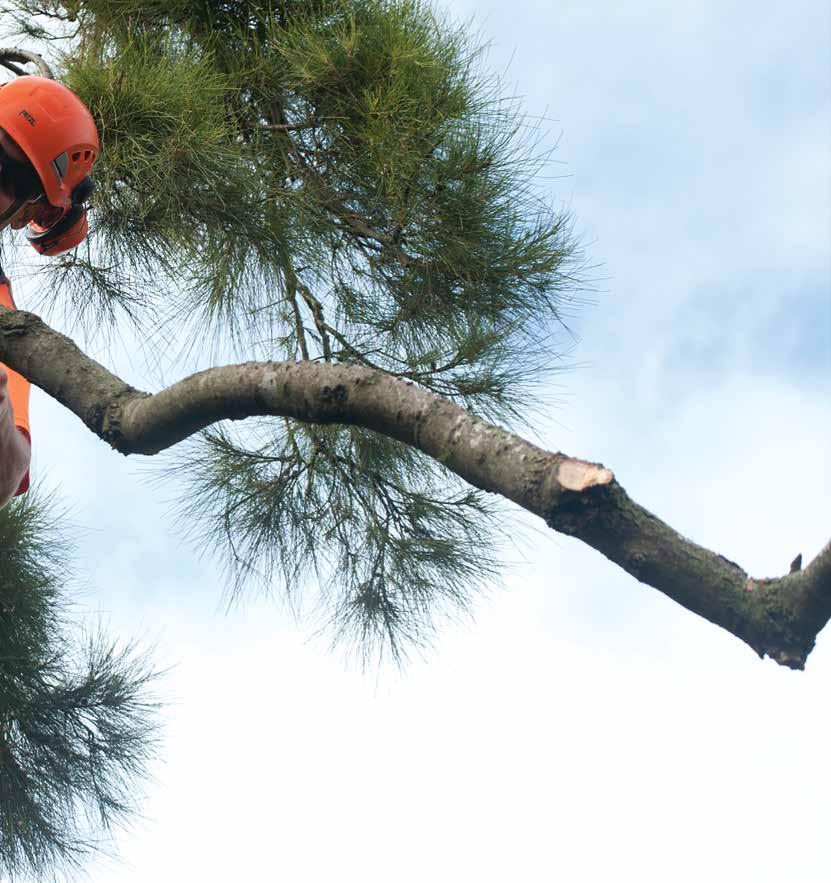
Working as a production faller for alpine logging operations for three decades, expert witness, Investigator for WHS incidents and Lead Auditor are a sound foundation for him to assist with improving industry safety.

JAMIE GRAY
Jamie has been a professional photographer In Sydney for over two decades. He is the owner of Camera, Hammer and Tong, who provides digital content for small businesses in and around the tree and construction industry. He is also a photo journalist and the product feature editor for What Tradies Want Magazine. But he’s just as comfortable with a hammer in his hand as a camera and pen.

The ATO has advised employers that if they missed or didn’t pay the full amount of their employees’ super guarantee (SG) for the quarter ended 31 December 31 2021, you’ll need to lodge a Super guarantee charge statement by February 28 2022 and pay the SG charge to ATO. It also emphasised that by law, it is unable to extend the due date to pay SG and that even if an employer can’t pay the full amount, they should still lodge an SG charge statement by the due date to avoid a late lodgement penalty. The ATO information also sets out how the SG charge is calculated.
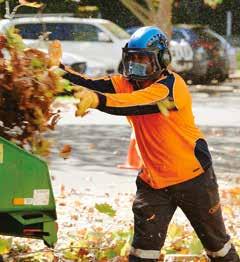
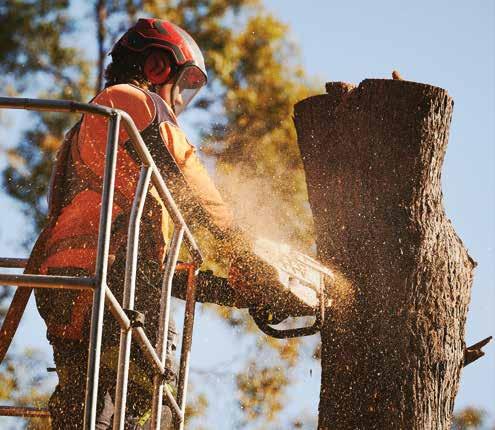
Super: ASIC warning SMSFs and crypto-currencies
ASIC has warned that it has noticed an increase in marketing recommending Australians switch from retail and industry superannuation funds to SMSFs so they can invest in a “high return” portfolio – especially cryptocurrencies. It has stated that cryptoassets are a high risk and speculative investment. As a result, ASIC is reminding superannuation fund members it is best practice to seek advice from a licensed financial adviser before agreeing to transfer superannuation out of a regulated fund into an SMSF.

For more information visit asic.gov.au/ about-asic/news-centre/articles/warning-selfmanaged-super-funds-and-crypto-investments/
The ATO has issued a reminder that individuals can now re-contribute amounts they withdrew under the COVID-19 early release of super program without them counting towards their non-concessional contributions cap. These contributions can be made between July 1 2021 and June 30 2030. The ATO also stated that individuals can make COVID-19 re-contribution amounts to any fund of their choice where the fund rules allow.
For more information visit www.ato.gov.au and asic.gov.au AA


No job is out of reach with the RUTHMANN Bluelift SA18HB tracked spider lift - designed for close proximity and rough terrain.

RUTHMANN Bluelift produces safe and reliable elevated work platforms that are simple and easy to use. The Italian spider lift manufacturer was originally founded by the Marti family in 2004. Ahern Australia is the exclusive distributor for the full line of Italian lifts in Australia. These Italian-made spider lifts feature advanced technology, lightweight designs and high performance.
Suitable for a wide range of applications, the flexible lifts work for maintenance, construction or industrial uses. The vertical and horizontal reach of the Italian lifts maximise production both indoor and outdoor. Carrying a platform capacity from 120kg to 250kg, the spider lifts have extensive ranges. Maximum working height reaches from 10.8m to 31m with horizontal outreach from 5.15m to 17.3m.
Ergonomic designs allow operators to easily move the lift into position, even in tight spaces. Proportional controls deliver precise manoeuvring to make easy work of accessing high places, such as trees and other tall objects. Bluelift also includes simultaneous electro-hydraulic capabilities for greater handling where needed. Combining a telescopic boom and articulating jib adds upand-over capabilities on many models.

For added protection, interlocking outriggers help the spider lift maintain balance on all terrain. A self-stabilizing system locks the spider lift into place for safe work at height. Hydraulically operated articulating outriggers can be set at individual heights. Optional non-marking rubber treads leave no trace on finished floors.
Compact and narrow, Bluelift spider platforms can fit in confined spaces. It is also designed to be lightweight and easily transported between jobs. Even the heaviest spider lift at 4,700kg can be towed by truck or trailer. The low machine weight allows each spider lift to operate on soft or sensitive surfaces.
The first-ever full hybrid solution meets industry needs for zero emission equipment. Three energy-efficient operating modes offer versatility by switching between battery power and combustion engine. On auto mode, the machine selects the most efficient power source to maximise battery cycle. Bluelift spider lifts meet restrictions for work environments requiring lower emission machines.
Popular among arborists in Australia, the 18HB model is ideal for many maintenance tasks thanks to its narrow width and lightweight design. With a maximum working height of 17.8m and maximum horizontal outreach up to 9.3m, this tracked spider lift can easily reach high elevations.

As a Bluelift Hybrid model, the SA18HB is a full hybrid solution that can switch from battery power to combustion engine. This industry-leading design delivers versatility as it reduces emissions in three energy-efficient operating modes.
All Electric mode allows the machine to be solely powered from a 90 amp/hr lithium cell battery whilst operating in a fixed position. Rapid recharging can be completed in approximately two hours with an on-board charger.

All Engine mode is operated from the combustion engine for full power and full speed. This is ideal for outdoor usage with the ability to travel long distances.

In the Auto mode, the spider lift can switch between battery power and diesel engine to offer the most efficient fuel saving mode.
The SA18HB can work for 4-5 hours of continuous use. Auto mode also delivers low emissions and reduced noise for environmentally friendly operation.
A radio control with multilingual display makes this machine a global product with the ability to be driven safely through tight areas and uneven terrain. The SA18HB is capable of climbing stairs for a wider range of indoor and outdoor applications. And with
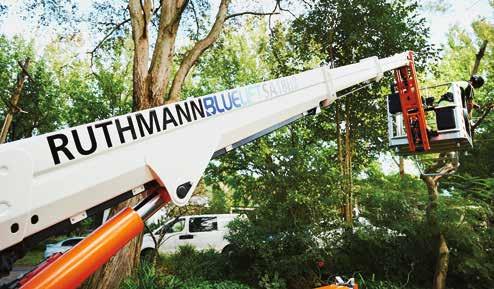



a gradeability up to 28 per cent, the selfstabilizing system locks the spider lift into place for safe work at height.
The SA18HB has a tight turning radius for navigating narrow landscapes and other areas. Its adjustable hydraulic chassis allows for precise positioning in any situation.
Ahern Australia carries the full line of Bluelift spider lifts including the C12/6.5, C12/6.5H and C12/6.5 HB; C13; SA11 and SA11P; SA16; SA18 and SA18HB; SA22; SA26; and SA31.

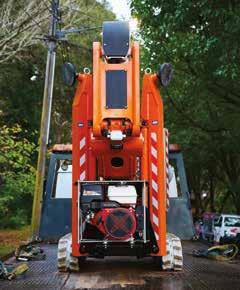
“Compact and narrow, Bluelift spider platforms can fit in confined spaces.”
Now that I am living in an Ecovillage personally, I see the Ecovillage movement as being a catalyst for conservation arboriculture; from a business perspective, with myself at the helm of the Naturaculture Network, I am using this report and project as an educational opportunity for Australian Arboriculture – this is to be discussed in Part 2.
My goal is to seed Arboricultural values in the global Ecovillage movement which places tree and land care higher in their valuing process than most private or government organisations (bar perhaps Botanic Gardens) that I have experienced.
Following a recent sickness and recovery time I am behind on writing Part 2 of my Ancient Fig Series. So have made this submission instead. This is a rerun, as having always intended a Part 2 on Tree Care and the Ecovillage movement, I now have this project in my sights.
Having been asked to follow up with project managing an arboricultural operation concerning this avenue of trees, I am rerunning the past 2019 feature article. This is on the topic of Conservation Arboriculture, based on a past report of mine for a S.E. QLD Ecovillage.

I am currently marshalling a team to carry out volume reductions on the avenue. This is stage 1 of hopefully a 3-stage project. The volume reductions are to reduce failure likelihood from gravitational failure and or wind load, also to trigger and generate internal canopy to reduce to in the future. To install maypole fall arrest for two of the trees exhibiting potential failure symptoms (intended to also be run as future Arborist workshops) and soil restoration for the whole avenue.
In support of the growing global Ecovillage movement, a movement that I see as part of the start of a potential golden age in promoting conservation arboriculture. Personally I hope to see us transition away from 70% tree removal and processing, into 70% Arboriculture (tree-culture), most arborists I believe wish to be tree custodians over being tree demolishers.
Having recently completed the following professional arboricultural report for Crystal Waters Ecovillage – Crystal Waters Community Trees Report – ‘The Trees on the Green’ – published October 7, 2019, I am running this technical report as a prelude to Part 2 which will also be published in a national Australian Ecovillage community publication. This is an edited version of the original report which can be seen at https:// bit.ly/33qSELo
I invite the AA readership to come on this journey with me. In part 2 we will be studying an iconic and ancient community Fig tree as part of the feature article.
Crystal Waters Community Trees Report - The Trees on the Green
Following a request from the Landscape Sub Committee for the Crystal Waters Co-op I accepted an unpaid commission to draft this report on the avenue of trees that make up the heart of the Crystal Waters communal area known as the Green.
Anybody who knows my work knows I have a great love for the organic grass roots arboricultural projects, that lead into quality arboricultural articles, and into further projects and education to be shared.

This report is principally a study on the five main trees that make up the avenue and are of key amenity interest subject to the greatest congregation of people. The report discusses the status of the trees as well as a management plan to integrate new trees over a 40 year window moving forward.
Background - Cassian in the Crystal Waters community
I first came to Crystal Waters in 2009 as a tree inspector working the Energex VTA Program (I helped found the program), when proactively assessing trees likely to fail on to the Electrical High Voltage Network (2007-12 Tin Can Bay to Central West Brisbane).
I returned in 2017 and became a resident where I lived at a number of properties with a number of hosts.
Though I have been moving around the world since then, I regard Crystal Waters as a home and am now part of the growing community passionate about sustainable living. In the long term I wish to invest in CW with a view of keeping a home base.
As a qualified professional consulting arborist (30+ years in vegetation management), educator and writer I have been working in S.E. Qld, as a qualified contracting arborist since 1991 and consultant since 2003 (I am currently at Diploma level - Australian Qualifications Framework - Level 5 since 2009 – upgraded to current training package in 2017).

I am a founder member of the Queensland Arboricultural Association (1994+), member, past committee member (1995-98) and past Technical Officer (2014).
There are a total of nine established trees – made up of the Genera Albizia, Tipuana, Grevillea and Jacaranda that make up the treed avenue bisected by the brick pathway known as Bricabrack Lane. The pathway is 83m long by 3m wide, the treed avenue is roughly 110m by 25m.

This is adjacent to a stand of Paulownia trees at the southern end that adjoin the plant nursery area, the Paulowinia trees are in reasonable order following my cleaning them out (dead wood removal) last year (with the ground support of Hayley Buchanan). The communal hall, deck and cafe is located on the eastern side of the avenue.
The gathering of visitors to the Crystal Waters Green is substantially increased on market days (first weekend each month) with a steady flow of locals and visitors attending
the Flower pot Cafe, bakery (eastern/western sides of the avenue) and other events. At the northern end of the avenue is the car park and entrance to the Green, another area of focused people gathering.
The reason I have selected the five trees highlighted in Fig. 2 as my key focus is because this is the greatest people traffic area, these trees are the oldest, are the most vulnerable to visitors, with T1, T4 and T5 posing the greatest long term risk to visitors. This is primarily due to stress caused by people pressure (note - all trees are stressed due to decades of soil compaction and biological desertification).
This report is for the CW community, though I have tried to keep it brief – I also intend for it to be published as a Conservation Arboriculture article in The Australian Arbor Age for professional arborists. This report will also be read by professional allied stakeholders (I intend to involve to help fund the avenue’s restoration – the Naturaculture Network), as well as being a future article for other national and global Ecovillages. The content is for both unschooled and professional tree people.
To enable a comprehensive understanding of my recommendations I aim to run an educational power-point presentation (subject to CO-OP approval) on the report to the CW community and will be open to questions to assist this process.
I am in a position to finance the tree restoration process by running a series of workshops (in a similar capacity to Steve Cran’s Permaculture CAP project),
You begin each day before dawn with a drive and determination to do more than the day before. When you move at this pace, you know to do more you need equipment that is made for more. That’s why our equipment is built from the ground up to meet your needs, delivering:
More Power and Production
Lower Operating Costs Ease of Maintenance Greater Longevity and Resale Value
If you’re ready to operate equipment that’s made to keep pace with you, then we invite you to contact the authorized dealer in your area of the world. To learn more about our equipment go to www.morbark.com
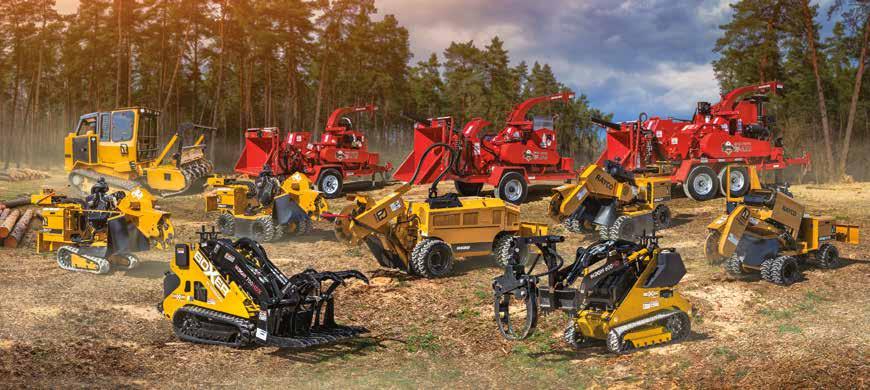
Morbark

NSW/VIC: Global Machinery Sales 1300 072 926 globalmachinerysales.com.au
QLD: Allclass Construction Equipment 1300 255 252 allclass.com.au
WA: Westco Equipment +61 (8) 9258 9333 westcoequipment.com.au
NZ: Commercial Outdoor Machinery 0800 26 66 88 commercialoutdoormachinery.co.nz
Boxer
NSW/VIC: Global Machinery Sales 1300 072 926 globalmachinerysales.com.au
QLD: Greenstar Equipment 1300767589 greenstarequip.com.au
WA: Westco Equipment +61 (8) 9258 9333 westcoequipment.com.au
NZ: Commercial Outdoor Machinery 0800 26 66 88 commercialoutdoormachinery.co.nz


NSW/VIC: Global Machinery Sales 1300 072 926 globalmachinerysales.com.au
QLD: Greenstar Equipment 1300767589 greenstarequip.com.au

hence my interest in drafting this report with a view to project managing this as a Naturaculture project.
Evidence of Genus, Species, Health, Dimensions and Crown Structure - T1 Genus and species
In the original report is a detailed record on Trees 1-5, in this version the report is briefly summarised.
T1, T3 and T4 – Albizia spp , until flowering time I am unable to get a positive identification on this rare tree (rare in Australia). My own study backed by feedback suggests that this tree is an African species, possibly Albizia amara or Albizia adianthifolia yellow flowered spp ), having not seen this tree outside of Crystal waters or in flower, I await flowering time for identification. I am however familiar with this Genus and a number of the local Genera in the family - Fabaceae (Albizia, Caesalpinia, Delonix, Tipuana). The CW trees and African species studied by me online fit the description of being a dominant canopy tree in dry African/Indian deciduous woodland (similar conditions in S.E. Queensland).
T2 – The Rosewood or the Pride of Bolivia – Tipuana tipu from South America is a popular amenity tree with global significance. This tree is regarded as a weed species in Australia and belongs to the same family as T1 – Fabaceae (https:// en.wikipedia.org/wiki/Tipuana).
Discussions with the community indicate that the Avenue was planted in the late ‘80s/ early ‘90s placing them at approximately 35-40 years old (since drafting this report leading Permacultural trainer Robin Clayfield confirmed she planted the trees).



When we consider the time frame taken to create the tree cover of Bricabrac Lane avenue it is in all out interests to keep these trees alive and stable for as long as is practically possible. From my perspective with modification to the site the trees lifespans can be extended in the order of decades. I am less concerned with the Tipuana trees long term (they tend to die before they shed crown structure – so when it comes to safety we get plenty of notice) because of their robustness – as I am the Albizia trees which are known to shed live limbs when stressed.
To this effect I will be recommending site improvements to all trees, but the treatment of the Albizia trees are first in the order of priority.
The long term management of the trees require community consideration, with the trees themselves being given the space to make improvement (by giving them a friable soil surface area they can better interface with) – this means sacrificing a reasonable percentage of area within the trees root zones for soil restoration. A sustainable management and action plan is in my opinion very necessary to reduce risk, stress on the trees and sustain this very valuable community asset. From what I can see with
Fig. 6
the Green we have plenty of space that we can share with the trees.
The constraints that are causing these trees to be in decline need to be understood and recognised by all concerned to enable the reasoning necessary to create change. Personally I would rather see a gradual process that supports the benefits the trees are currently providing extending into another 40 years, rather than a time lag where following tree removal and a greater deserted landscape it takes another 40 years to establish new trees to achieve what we have now. It is normal in most reactive tree management situations (based on a lack of value to be realised in retention over removal and processing) that an avenue such as this be felled then
replanted as soon as trees shows symptoms of age. Imagine if we humans were ‘felled’ as sick 25 year olds rather than be nourished to live out our full lifespans?
Because of non-sustainable treemanagement practices trees rarely make it to maturity (the first ⅓ of their lifespans) before the onset of early old age and their removal.
The constraints on the trees/site are as follows:
• Lack of soil oxygen due to Soil Compaction due to decades (pre and post planting) of People Pressure from vehicles, machinery, hooved animals (bullock timber trains, dairy cows) and site visitors (multitudes of feet)
• Below ground Biological Desertification due to decades of compaction, loss of leaf litter and lawn competition
• A lack of soil water holding capacity after rainfall, compacted biologically desertified soils (soils low in fungi do not hold water for long) and lawn grasses have significantly greater impacts in times of drought. Wood embrittlement due to drought stress is a factor in major limb failure
• Limited budget for tree maintenance or removal (from my perspective this is also a benefit - detrimental over-pruning is a common issue where budgets exist)

• Reduced tree health due to site constraints, the Albizia trees (more particularly) now with advancing signs of decline
• Expected time frame for another major limb failure – within five years
• Due to overshadowing/space there are limited options for the successful establishment of replacement trees (replacement planting sites between the existing avenue trees is right within access routes and market stalls), in this case the establishment of Figs is the best practise option
• ‘Tree time over Human time’ – because human life spans are so short and the processes that make up tree time are much longer – few of us have the understanding to accommodate full tree life expectancy
As stated based on the stress that the trees are under – they are in a stage in their growth cycle where due to the limits imposed upon them they are becoming old before their time. However I see these trees at a switching point in their vitality – whereby (based on stored energy) they can make a comeback (optimise their bodies) with help.
Most amenity trees in the urban environment are recoverable, but not so under the reactive land and vegetation management system that is common to most private and public land holders in the world. Proactive tree management means addressing the needs of trees before they go into decline, before they fail or die.
Crystal Waters (as a potential global hub for sustainability) has a great opportunity with these trees, by initiating and being part of a proactive project concerning this Green community hub, Crystal Waters could well be the first Eco-village in the world to save a treed avenue into posterity (this rarely happens in the mainstream globally outside of historical trees in Botanical Gardens).
Considering the major limb failure last year (T4), risk needs to be another motivating factor for change, though with my overall recommendations in the long term I am confident that risk can be managed to an acceptable level. In support of the trees it needs to be stated that apart from the 2018 limb failure on T4 in the last 30+ years these trees have no history of recorded risk/ hazard (bar one recent trip hazard incident from a raised brick). Assuming no action is taken considering risk, human occupancy of the site (the number of hours people are under the trees) and the likelihood of a limb failing and falling on a person – I suspect that the trees are barely on the threshold of risk. Based on the current established target level of risk – being 1 in 10,000 or less (Ref: systems of assessing Tree RiskVALID - Tree Risk-Benefit Assessment and Management and QTRA - Quantified Tree Risk Assessment). Of course with no action taken the trees will continue to decline from people pressure with the likelihood of tree failure escalating and therefore risk of harm.
I intend to organise a workshop to enable an independent risk assessment to be carried out as part of the project management plan
I have for the trees (this I aim to host as a workshop to help raise revenue) should my proposal be accepted by the Co-op.
The steps listed in section 4.0 will collectively reduce risk likelihood well below the risk matrix that professional consulting arborists like myself follow.
People Exclusion Zones - PEZ - reducing targets (on people) whilst reducing people pressure (on trees)
To facilitate the recovery of these trees we need to give a significant amount of space back to them. This means reducing people pressure – people access/congregation (and therefore soil compaction) within the trees root zones (from the trees trunk to the trees driplines) by making designated areas no go zones – PEZ – for people and then making those zones soil restoration areas.
With the goal to make the soil’s friable, to improve on soil health and therefore tree health.
The Bricabrac lane treed avenue roughly measures 110m by 25m (including an extra 15m² to encompass T5) that is an overall area a little under 3000 m².
Currently this whole area is used by people and subject to people pressure, the community need to agree on how much space they are willing to give back to the trees. The brick lane itself takes up approximately 300m², the trees trunks/non treatable structural root zones a further 36m² (4m per tree *9 trees = 36m²). Less the non treatable areas that leaves 2639m² for potential treatment.
Allowing for monthly market stall space is the crux of the issue that will fuel resistance to giving the trees room to breath (as discussed for long term health oxygen in the root zones of woody plants is essential).
If the community is not willing to facilitate space for the trees it will not be viable to make the needed improvements to support
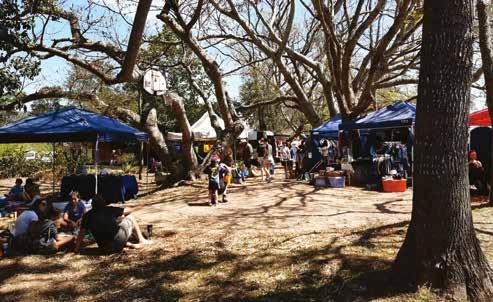
the restoration of the trees health. Out of the overall 2639m² of space that the trees need to improve we need to return at least ⅔ of this area to being a healthy friable biologically active soil, that’s 1800 square metres. This area to be comprised of gardens decking or cellular confinement systems. Within this area where people access and market stalls are paramount – we need raised walkways as beneath this zone it is critical that soil friability is improved and sustained.
The community needs to very carefully consider the benefits the trees give versus the costs the trees pose. Which is the greater cost to lose the current avenue and start again from scratch?
This means paying for the trees to be felled and processed, with stumps ground (a cost of up to $10,000 for the three Albizia trees alone), to then carry out soil restoration and treatment with new trees planted followed by 30-40 years of growing time to achieve the current green tunnel that is Bricabrac lane.
The alternative is to retain the current trees but give them the growing space necessary to facilitate the health improvements needed. To do this without great financial cost will mean sacrificing a number of market pitches, if the community are not willing to make that sacrifice then the only solution is to establish raised timber decks or to establish cellular confinement systems over the root zones designated to be restored (this is cheaper than decking though involves changes to the ground surface and financial cost).
Most amenity trees in the urban environment are recoverable, but not so under the reactive land and vegetation management system that is current to most private and public land holders in the world. Proactive tree management means addressing the needs of trees before they go into decline, before they get sufficiently stressed that they fail or die.
As proposed Crystal Waters has a great opportunity with these trees, by initiating and being part of a restoration project concerning the Green Avenue, with being the first Eco-village in the world to do so. As well as project manage such an event I am willing to also draft an article on such a project to share globally. To be true this is my main drive for being in service to the trees and the community, though with my history of project management this project would be in the top 10.

Though for me to be in a position to project manage these trees firstly my vision needs to be understood, then deliberation can arrive at an agreed plan. I am in a position to raise funds for the restoration of the trees by running workshops to cover the cost of materials, labour and arboricultural expertise, though regardless of how this is funded or how the project is designed without gifting the trees a minimum of 1800m² in space then the project is unlikely to achieve success. That advice relates to the replacement trees too, as the existing trees have utilised most of the available resources within the soil.
Soil Inoculation, Nutrient Bed and Plant System establishment (within the Exclusion zones)
Trees as woody plants obtain their nutrition via microbiological association in the trees nutrient absorbing interface known as the rhizosphere – this is literally the ‘stomach lining’ of the tree/soil. The nutrient cycle essential to tree longevity is a natural synthesis that can not be replicated by mankind (people can only sustainably work with the cycle), the rizosphere is retarded/ damaged by fertilizers, herbicides, pesticides, soil compaction and desertification.
The most sustainable strategy for facilitating optimal tree health involves the use of organic cold processed humus. This is not available in landscape yards, nor from tree processing contractors, the products available from Bunnings are not biologically active (are not a true compost, the microbiology in humus with a very limited shelf life can only be sustainably handled over short time periods). The humus that I use/have access to is farmed sustainably largely from green vegetation (a by product of tree prunings and removals).
As well as vertically and horizontally inoculating (Soil Inoculation) as a means to decompact soils, I construct Nutrient Beds to house the biologically active medium necessary to (naturally open soils up), to provide nutrition as well as protect the integrity of the inoculated soil medium.
The Nutrient Beds are then capped with a vegative layer – by establishing a Plant System (plant component of an ecosystem) comprised of companion plants that form closed canopies further proofing the system as well as creating high value amenity gardens for site beautification.
The establishment of such systems are self regulating and maintaining as long as people keep off the system. The combined effect of soil inoculation, establishing nutrient beds and plant systems significantly reduces drought stress by holding moisture in the soil. The periodic Irrigation of the plant system helps drought proof trees, hydrated sapwood helps to prevent major limb failure even with the presence of wood decay fungi.
The purpose of cellular confinement systems (in our context) is to enable access to restored tree root zones without recompacting soils. Such a system is laid out over geofabric and is made up of a cellular matting filled with angular gravel, another similar load bearing system supports lawn grasses.
In those areas where the community is unable to sacrifice market stall areas as space for trees – cellular confinement is the greatest option, though timber decking is another.
(T1 and T4) and propping of lower limb T1 As well as tree health a sustainable management plan must also include risk management.
My main concern is major limb failure, as discussed this relates to the Albizia trees, because of their body language, their stress symptoms and because T4 has already had one major limb failure I am inclined to

recommend establishing a fall arrest system to help mitigate further limb failure. This can be seen akin to training wheels for human toddlers. Though the trees are highly stressed young adults – whilst their vitality improves a back-up system brings us a step closer to being well under the acceptable tree risk threshold. Mechanically speaking the trees have recently been demonstrating their prowess to dealing with major wind load – this is evidenced by my study of the trees in response to the heavy August/ September winds.
Generally speaking, where possible, I recommend pruning of trees via volume reduction as a means to reduce limb failure likelihood, however I believe that any pruning on the Flamboyant trees will accelerate their health decline (wounding into heartwood enables oxygen ingress and an acceleration of wood decay, particularly on stressed trees) therefore as a means to help mitigate failure whilst their health levels improve (and therefore their mechanical capacity) I recommend the Maypole rigging system.
This involves setting up fall arrest from a timber pole (power poles are ideal), which is established in close proximity to a trees trunk (not too close to cause damage) yet established to be as central to a trees crown as possible. With fall arrest running from the upper pole to selected crown structure (to be ascertained by me) as a means to arrest structure likely to fail.
VERMEER AUSTRALIA HAS BEEN AT THE FOREFRONT OF INNOVATIVE SAFETY AND PERFORMANCE FEATURES IN OUR TREE CARE RANGE FOR MORE THAN 60 YEARS.

The BC2100XL is a standout in our wood chipper range. With a full function remote control, and offset horizontal feed roller, disposing of tree materials has never been safer. Plus, you’ll be backed by the service and support of Australia’s largest tree care equipment dealer network. Contact your local Vermeer Australia team to try it for yourself.
 VERMEERAUSTRALIA.COM.AU | 1300 VERMEER
Vermeer and the Vermeer logo are trademarks of Vermeer Manufacturing Company in the United States and /or other countries. © 2022 RDO Equipment Pty Ltd (trading as Vermeer Australia). All Rights Reserved.
VERMEERAUSTRALIA.COM.AU | 1300 VERMEER
Vermeer and the Vermeer logo are trademarks of Vermeer Manufacturing Company in the United States and /or other countries. © 2022 RDO Equipment Pty Ltd (trading as Vermeer Australia). All Rights Reserved.
I also recommend (in association with our resident builder) to create and install a prop for the lowest limb on T1.
Structurally speaking, I see the retention (without pruning) of this limb as being paramount to the trees overall mechanical capacity to dampen wind load. Propping the limb is likely to buy the tree decades of sustained functionality. Based on experience the removal of this limb is likely to cause upper crown failure in wind events (removal of this limb will also cause major wounding/oxygen ingress) with photosynthate loss and subsequent decay undermining its adjacent trunk – this will seriously mechanically compromise the trees upper crown to deal with wind load.
Note 1. I recommend removing the line covered flags, setting a pole to attach them to, because of the status of this tree we need to discourage climbing of this tree by our children, that means keeping the adults out too. By the time we have set up the exclusion zones (PEZ) for this tree, we will only have people walking under her, so further reducing risk (and people pressure).
Note 2. Because of the stress the Albizia trees are already under it is possible
that another limb failure may occur post treatment works (the trees will need integration time – up to five years), the goal in the meantime is to mitigate risk through establishing exclusion zones backed with the fall arrest system (Maypole Rigs) discussed.

Note 3. With regard T5 (no Maypole planned for this tree) I recommend sustaining this trees
integrity/reducing risk through establishing an exclusion zone and light pruning.
I see the installation of native Ficus species (Child trees) to engulf host trees (Parent trees) as being the best means to maximise space, whilst utilising the
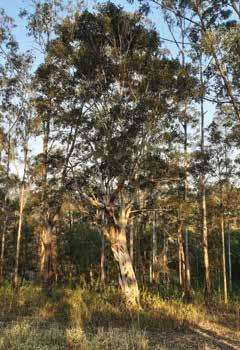
Fig. 10

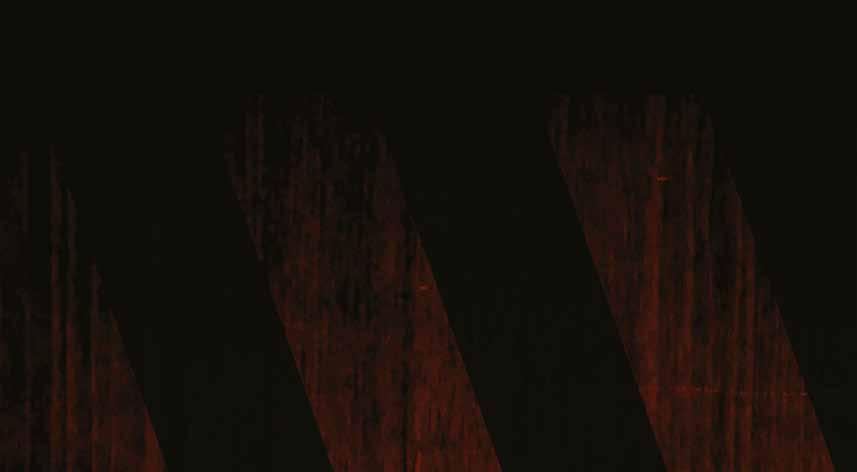






established woody trunks/root plates of the existing trees and compartmentalising them. The restoration of the current treed sites as part of the health management of the existing trees will also facilitate the optimal future health of the replacement Fig trees. By growing Figs on the avenue trees this saves using space between the avenue trees for tree replacements.
The natural precedent of Fig trees growing on and engulfing host trees is a phenomenon that is classic to S.E. Queensland (and the tropics) and is a best practise means to replace local veteran trees with new ones. This strategy is brilliant for stabilising veteran trees (such as the avenue trees) whilst providing an established body for the Fig tree to grow on, as well as being an excellent way to grow a native tree over one listed as a weed species. With consideration of local trees to grow as child trees I recommend two species – Ficus obliqua (Evergreen) the Small leaved Fig and F. virens (deciduous) the white Fig.
As a means to assist the engulfment of
the replacement Fig trees I recommend the utilisation of Coir (coconut fibre) tubing, this enables the acceleration of the establishment process as well as help target the root system of the establishing Fig tree/ soil/root area. I recommend installing three Figs per tree (F. virens on the Albizia trees), and three Figs (F. obliqua on the Tipuana trees). Each tree to have 3 Coir tubes per tree linking the Figs to ground, each tube to be split and filled with leaf litter/humus to accelerate the process. I recommend that the figs be installed low enough to the ground to be irrigated (hosed) once per month during establishment phase.
Key site modifications (Ref: T1 and T3) needed to reduce risk and reduce stress loads on trees
To help accommodate the needed site improvements around T1 I strongly recommend the relocation of the trampoline and potentially the swing set, at least to the edge of the trees canopy. As well as it being important to reduce people pressure within this trees root zone with the long term

in mind we also need to reduce people’s exposure to potential risk from this tree. I see the need for T1 to be an exclusion zone for most if not all of its dripline (bar Bricabrack lane as an access route).
Likewise with regard T3 the fire pit needs relocating to beyond the trees canopy. In the long term the constant radiation of the soil/ soils microbiology will significantly reduce the lifespan of this tree.
At the heart of Crystal Waters there is a treed avenue (Ref: T1-T5) in need of human support if the avenue is to have a sustainable future.
This report is a result of a request from Ally Bing of the Crystal Waters Landscape community sub group for professional arboricultural advice.
This report has been drafted as a professional document though is free of charge, it specifically covers five of the main avenue trees but relates to the whole avenue of Bricabrack lane. Personally I elected to take on this work as I see a great opportunity to be in service to the Avenue trees, the community, as well as to cocreate a precedent for Ecovillages globally to take on proactive tree care projects.
For these trees to be integrated into a replacement canopy moving forward action
“In the long term the constant radiation of the soil/soils microbiology will significantly reduce the lifespan of this tree.”
needs to be taken now. The course that I recommend is for the Committee, the Co-op and the community to discuss and agree on an action plan, a plan that reflects the needs of the trees and the community, that values and integrates the two. It’s my job as an experienced Project Manager interested in championing this cause to help the community see what I see as a long term management plan, to then mediate the steps to bring that into reality. I will assist this process through running a 40
minute presentation with a question and answer session, I suggest doing so via the community Eco-centre.
The management steps I am to initiate to enable a successful outcome are as follows.
1. To achieve the support of the CW Landscape Committee, Markets managers, Co-operative and community, this will involve careful discussion, demonstration and negotiation to achieve the objective of giving the trees sufficient space to better interact with their soil environment, to therefore be able to improve their health and biomechanical status
2. To share this report with the Stakeholders I have a history with, with a means to gauge the kind of support I can attract for the trees (this was already acted on with the relevant parties at the time of completing the 1st draft of this report)
3. To plan the engineering components, particularly in association with the Maypoles rigs and prop (T1 and T4)
4. To price the associated costs necessary to gauge project cost and management
5. With the aim to cover the associated costs through running a number of
workshops (to the Australian arboricultural profession and allied professions concerned with tree management) I will ascertain a budget as a means to allocate funds to pay for the works. The number of workshops and trees I aim to service per operational step will feature in an Operations Plan (to be developed)
6. To gauge from the Co-operative what is willing to be given in support of this proposed project, i.e. use of the Eco-centre and CW accommodation to help keep workshop costs down and to build revenue for the proposed restoration project.
The practical steps I recommend to follow to enable a successful outcome.
• In association with the Landscape Committee to map out the areas for People Exclusion Zones, Vertical Inoculation, Nutrient Beds, Plant Systems and Cellular Confinement Systems (for market pads and people access walkways)
• Working with the Landscape Committee to relocate the trampoline, swings and fire pit

• To establish an order of trees to be treated based on priority and workshop funding, to then treat each tree in succession (Maypole Rig, Nutrient Bed, Plant System, Cellular Confinement System, tree pruning and Fig tree planting)

• To establish a maintenance plan
• To discuss with the Committee news of any intended development projects that are likely to impact on any of the trees discussed in the report
To help establish a benchmark for Eco Villages globally with a proactive tree management project such as this, I intend to further develop this report as an arboricultural article and an article for the Ecovillage community Australia wide. Should I gain approval to project manage this proposed project subject to funding, I aim to record and promote the restoration process in a series of future articles.
With over two years since drafting the Crystal Waters arborist report, as project manager I am very excited to be working on Stage 1. Moving forward as originally intended I am expecting some very interesting work, arborist workshops and future articles. AA
“For these trees to be integrated into a replacement canopy moving forward action needs to be taken now.”
How should trees be pruned? That depends – on the condition, species, and location of the tree, the objective, the budget, and other variables.

Can one standard be written to show arborists how to prune all trees? This is a quick look at the first draft of a European Tree Pruning Standard (ETPS), from a perspective of previously serving on the US corporate tree care standard (A300) committee, and also consulting the more comprehensive British (3998) and German (ZTV) standards. You can download ETPS for free at www.eac-arboriculture.com, follow along, and tell me where I go wrong!

Echoing the ZTV, ETPS has three levels of emphasis about practices: can, should, and must. The A300 has shall's and should's, the 3998 is fuzzier, with only should's. ETPS advises users to avoid removing the ecosystem services provided by tree


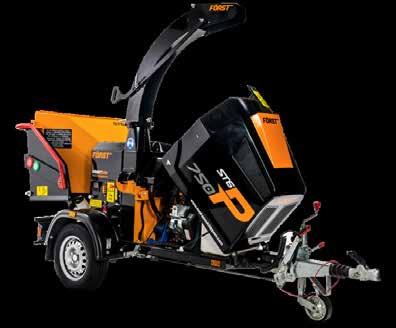


branches for some human-caused problems, including solar panels and signal receivers. Relocating these things can be less costly than repeatedly damaging trees.
Essential people-based objectives for pruning include safety, clearance, and increasing benefits. The tree-based default objective in the ZTV – maximising health, safety, and vitality – is regretfully omitted.
Safety requirements for arborists, the site, and the public are set forth early and clearly. Establishing an emergency route from the work location to the road to the hospital, PPE, first aid, contact information; all are required. The aerodynamic effects of pruning on the subject tree and adjacent trees must be minimised, along with the damage to the living soil and the habitat in the tree itself.
Chainsaws should stay on the ground for many pruning jobs. ETPS has a 5cm minimum for chainsaw use, but in many trees this could be 10cm or even 15cm. The general rules properly begin with a preference for smaller cuts, farther from the stem. Wound size should be limited to


5cm in weak trees and 10cm in trees with stronger compartmentalisation. This is consistent with research, 3998, and ZTV. A300 suggests a 15cm maximum.

ETPS advises that the diameter of a side branch being removed should not exceed 1/3 of the diameter of the parent branch. This is a new 1/3 rule, and a wise consideration of aspect ratio. Larger wounds are unlikely to close very well. It also recommends leaving a distance between wounds of at least the diameter of the largest wound. If this can’t be avoided, then pruning should be done over time, to avoid decay connecting one wound to the other.
Deadwooding is a prickly topic that is sorted with a chart showing different approaches for formative pruning, crown maintenance, and veteran tree care. A similar table discusses the best timing for pruning for different objectives. When leaves are either forming or falling, some pruning should be avoided, as Alex Shigo noted long ago. ETPS advice on wound dressings is limited to general avoidance. The A300 lists exceptions to this
general rule, to discourage pests and avoid cracking and for aesthetic purposes.
For branch removal, standard methods are consistent. For branch reduction, an important note is made to preserve the tree’s natural form by pruning back to laterals that are growing in the same general direction. This maintains biomechanical stability by avoiding defects such as “doglegs”. Sadly, all four standards advocate the discredited and disastrous 1/3 rule: that the size of the remaining branch should be at least 1/3 the diameter of the cut portion, regardless of the instability those cuts can cause. A recent dogleg failure killed a baby, resulting in a $13.75 million USD award to the father.
This ⅓ rule violates natural tree growth habit and has no place in mature tree care. Why? Leaving a large lateral is recommended when managing younger trees, because its terminal role spurs outward growth. But on mature trees, outward growth increases risk of failure. Inward and downward growth is the goal. This pediatric ⅓ formula, no matter how often it is parroted, has no place in geriatric or mature tree care. Preserving the natural growth habit makes clients say, “It does not even look like that tree was pruned.”
ETPS properly allows two “shaping” exceptions to preserving the natural habit: pollarding (“knuckle cutting”) and shearing or topiary (“trimming”). But intentional wounding to provide habitat, with rip cuts

“ETPS advises that the diameter of a side branch being removed should not exceed 1/3 of the diameter of the parent branch.”Fig. 3: Some deadwood is best left alone. Fig. 4: Ruining tree form by following faulty formulas invites disaster.

No job is out of reach with the RUTHMANN Bluelift SA18HB tracked spider lift - designed for close proximity and rough terrain. Popular among arborists in Australia, this model is ideal for many maintenance tasks thanks to its narrow width and lightweight design. With a maximum working height of 17.8m and maximum horizontal outreach up to 9.3m, this tracked spider lift can easily reach high elevations. A self-stabilizing system locks the spider lift into place for safe work at height.

or coronet cuts, needs more explanation. Limiting these cuts to some species, for a few objectives, in certain locations would avoid excessive wounding.
Structural pruning is nicely set out and illustrated. However, pruning near utility wires draws the mutilating “ground to sky” line. Cutting lower branches that are nowhere near the utility wires, and never will be, exceeds the clearance objective. ETPS illustrates an excessive loss of ecosystem services, far beyond clearance needs. Crown reduction to increase stability aims strictly at the upper crown. But A300 addresses the need to reduce the sides as well, because wider trees twist more in the wind. A follow up inspection is recommended, to look for response growth and sun damage. Better to avoid sun damage, by retaining small laterals, late in the growing season, and applying reflective paint on thin barked trees.
Excessive crown raising is clearly illustrated, showing the centre of gravity getting higher and the risk of tree failure also increasing. The description of pollarding is similar to what Alex Shigo

described in the 1980s; limited to creating knuckles, and starting on young trees. Managing tree size with repeated pruning near, but not at, previous cuts is commonly done, but has yet to be standardised.


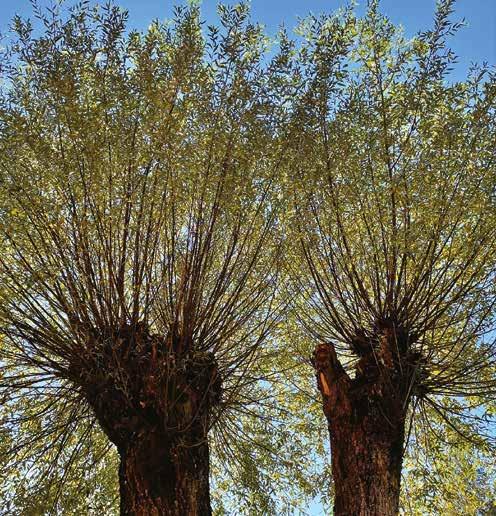
Next, the stages of tree development are described in a chart, to explain why our actions are different for older trees than younger. The definition of a veteran tree is adopted from the VETree certification program, which is also funded through the European Union. In many locations, some amount of crown raising must be done. All the standards clarify the clearance needed over roads and sidewalks. But none mention how, why and where lower branches can and should grow closer to the ground.
Formative pruning is well detailed, but ETPS advises waiting three years. Some young trees are well formed, but many have severe problems. These must be addressed at planting time, of course avoiding too much branch loss when roots are lacking. The differing architecture of tree species is addressed here, comparing straight single leader excurrent trees to two more irregular and decurrent forms. This is an excellent start at integrating our knowledge about tree architecture into our practice of tree management.
Section 5 considers the differing management of trees at different development stages for different objectives. For crown reduction of mature trees, ETPS links formulaic methods of calculating load. Yet the limitations of mathematical modeling are not disclaimed. And the optimal season for this work just “depends“? Can there be a better time than late in the growing season
For veteran trees, the primary objective is mistakenly defined as weight removal to improve stability. Too often, wood is taken out, where twigs would be enough. It’s load that needs to be reduced for mechanical stability. Load equals weight times movement: “It ain’t the meat, it’s the motion”, as the raunchy old jazz song put it. This basic but common error throws the primary rule of smaller pruning wounds out the window and enables mutilation. In practical experience, there is rarely a need to exceed the 10cm limit for mature or veteran trees.
On a positive note, ETPS strongly advocates preserving internal growth and habitat. Restorative pruning is thoroughly covered, matching the terminology but going beyond the descriptions in the A300. Tolerable crown loss varies with the tree’s age, and the pruning interval can be up to five

years. Too often, trees are removed, because the need for follow-up is wildly exaggerated.
Section 7 briefly deals with planning and expands on points made earlier in the standard to lessen the impacts on the soil and the neighbouring trees. The first appendix lists good and weak compartmentalising species. The third appendix lists three different architectural models, and then describes the best ways of formative pruning for each one. Standardizing more nuanced pruning strategies, according to the dozen or so architectural models, is the next challenge.
Overall, this draft standard is a valuable addition to the guidance available to arborists around the world. When in doubt, we can now look to the ETPS for directions. Collaboration by entities in 24 different countries is a great leap forward.
Tune in next issue, when we will see how Australia’s MIS pruning standard continues our quest for an international tree pruning standard. AA
Bandit Mobile Service trucks are launching soon. All part of our promise to deliver outstanding customer support and backup across Australia. We’re here to support your success. More to come!

Advance Tree Works – heading in the right direction.
Who are the owners of Advance Tree Works?
Advance Tree Works is owned by Owen Hardy.
After working for and managing various companies for 25 years, I found myself jobless. I had lost my licence and sat around for three months not sure what I would be doing. During that period, I was depressed and could not see a future. Being in my forties, without a licence I struggled to see any future. The important action I took, even depressed, was to reach out for support. I made a call to my friend, Bud Quaid, who
put me onto a contracting lead. That simple call and support from Bud Quaid made the difference. I borrowed $2000 from mum and Bud gave me $1250 to start my company in April 2015

At the start, we won a major contract in the powerline industry with Active Tree Services (ATS). After three months into the contract, we had a couple of incidents and lost the contract. Fortunately, ATS supported us and kept us going for another 12 months. We returned to Queensland with enough gear to keep us going within the private sector. We placed a $50 advertisement in the local

paper and that kicked us off. We became associated with Enviro Frontier, local council and other Government departments.
We put a lot of time into training our staff and upgrading our gear. We had $70,000 worth of equipment in 2016 and over $2M at the present time. It’s been a real slog with its ups and downs.


What are three things people will say set you apart?
Professionalism, quality staff and training as well as quality gear.
What have you found exciting?
Continuous growth, watching apprentices grow, the opportunities in our industry and new technologies.
What have been the pressures in the business?
Workload, targets, staff, overthinking, always wanting to be the best in our area and always wanting more, trying to find ‘me’ time to enjoy my family and have a proper holiday.
What has been the pressure or expectations you put yourself under? I have been taking on too much at once.
Did you believe you were letting people down?
Yes
Are you OK now?
Who were they and why?
They were my family. I was too absorbed in what I was doing.
You’re a business owner, a father –what expectations did this have on your thoughts?
My expectations were to be successful and my thoughts were on the fear of going broke and not being able to support staff and especially my family.
Did you reach out to anyone for mentoring or support?
Yes.
When and why – what made you decide to reach out?
I’m lucky enough to have several mentors that I’ve bounced off throughout the last six and a half years; Bud Quaid, Mark Willcox, Luke Hobbs, Tim Carbis, Andrew Baxter and Bob Wicks just to name a few. I reached out to them purely out of frustration and lack of knowledge as I considered these guys to be leaders but, most of all, who I trust and who would give me a push in the right direction.
What was the mask you believe you hid behind?
The ‘I’m OK’ mask when I wasn’t OK.
I feel I am heading in the right direction.
Where are you now on your journey?
I feel like I’m three parts there.
What do you share with yourself, family and team (staff)?
My goals, visions, failures and success.
What do you need the “macho” tree industry to hear from you?
Take the industry seriously, encourage and support each other. We all have our ups and downs. Band together and remember, it ain’t weak to speak and talk to your mates. If you ask people will listen. The biggest one is there is no dumb questions. By myself just reaching out years ago to support, especially when I was depressed, helped me get back on the journey. Just ask
When a “hurdle” in the road, how do you reach out to let us know it’s OK?
At times I find it hard to reach out but it’s important to talk to your mates, involve yourself and surround yourself with good people as good people will always look after good people. I’m lucky enough the strong circle of family, friends, my employees and likeminded business people I am involved with, being the Beach House Fishing Club, always checking up on me and the trust in this group, encourages me to have a yarn and open up.
What can we do to make it OK?
Be aware, many do hide behind masks and not all is what it seems. Ask the question ‘are you OK?’. Make them look you in the eye, ask again and if you look hard enough the answer is there. Just be aware and remember, it ain’t weak to speak and talk to your mates and if you can’t talk to your mates find somebody, anybody and they will listen.
Special mentions to my beautiful mother Jean Hardy, my son Zack Hardy, my loving girlfriend Diane Moubarak who has to put up with my outbursts and all the people I mentioned in previous questions. To all my valued employees for understanding who I am and supporting me throughout as there has been many ups as there has been downs and Advance Tree Works would not be the successful company it is today.
Kind regards, Owen Hardy. AA
“Band together and remember, it ain’t weak to speak and talk to your mates. If you ask people will listen.”
Trees are a resource on farms as they create shade for livestock and habitat for wildlife. The retention of trees is desirable on farms unless they present risk of damage to people or property. Any tree poses a level of risk, however the location of a tree on a dam wall has the potential to increase this risk further.
It is recommended by various NSW government bodies to avoid planting trees or deep-rooted shrubs on dam walls as roots can cause seepage, or the collapse of the dam wall (Water NSW 2011 and LLS 2021).
The inevitability of tree removal can also be a reason to avoid planting trees along dam walls or embankments, as the removal of the trees roots allows for seepage of water (Omofunmi et al 3017). Tree roots also can attach opportunistically to dams and they can have waterlogged roots which may be weaker.
Compaction of the soil by loaders and trucks squeezes the oxygen from the soil thus depriving the tree of the oxygen it needs to survive (Sullivan 2019).
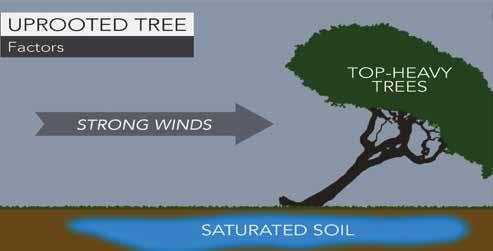
Trees like Salix sp Willow can be tolerant to saturated soil but are less dense and more likely to have root detachment in dam walls. The reason farmers may use these type of trees are they can be a secondary source of fodder.
From a dam engineering perspective, trees that are located on the crest of a dam have the potential to affect the outflow of
Water slows and is absorbed into the soil
water from the dam which creates additional stressed to the dam wall (Chanson and James 1999).
Trees uprooted by storm damage on a dam embankment increase the failure potential as there is a high probability the void formed in the uprooting of the tree will lead to erosion and create a spillway (Amegashitsi 2016).
Large roots from trees can block drainage systems in dams, lead to undesirable changes in the soil, or cause piping, that is, the change of the water flow which can lead to erosion (Laasonen 2013).

Piping in particular can be a serious issue that can lead to whole dam failure, and this risk increases with large roots or roots with mould cavities (Evans et al 2000). However, it is noted that the risk of any individual tree will vary by case (Laasonen 2013).
In the mining country there have been remedial cases where trees have been removed to ensure the dam wall is structurally intact.
Root mapping of trees along dam walls
The commissioner on a recent Land Environment Court case referred to the use of trees on dam walls as an issue for development. This article reviews literature that explores issues regarding trees and dams.
would be useful in determining the extent of the root penetration.
Sampling the structural root zones within the root mapping process for encroachments into the dam wall. Secondary issues arising from installing fencing or drainage installations where soil is disturbed and can allow for the opportunistic roots.
Finally, anyone who has walked along the dam wall would notice that debris can build up and inspection of the surface is hindered once vegetation is allowed to establish.

The illustration describes how different parts of a dam will benefit from different vegetation types. For example, any vegetation on a dam wall should only include shallow rooted plants and a filter zone should include groundcover plants such as sedges and rushes. Trees in a shade zone can help reduce water temperature in warmer months, discourage the growth of water weeds and benefit fish and other wildlife living in the dam.
1www.regenerative.com/magazine/sixsteps-building-swale Amegashitsi, E. A. (2016). Earthen Dam Rehabilitation at Rancho la Union in Zapata County, Texas (Doctoral dissertation, Texas A&M University-Kingsville). Chanson, H., & James, D. P. (1999). Siltation of Australian reservoirs: some observations and dam safety implications. Department of Civil Engineering, The University of Queensland, Brisbane. Evans, J. E., Mackey, S. D., Gottgens, J. F., & Gill, W. M. (2000). Lessons from a dam failure. Laasonen, J. (2013). Risk of the trees and the stumps to the embankment dam safety. Experimental study. In IECS2013, 9th ICOLD European Club Symposium, Venice, Italy. Omofunmi, O. E., Kolo, J. G., Oladipo, A. S., Diabana, P. D., & Ojo, A. S. (2017). A review on effects and control of seepage through earth-fill dam. Current Journal of Applied Science and Technology, 22(5), 1-11. Land For Wildlife Local Land Services. (Accessed 22 July 2021). How to Manage
And Maintain Farm Dams. State of New South Wales.
Sullivan Bill (2019) KTC A Guide to Amenity Tree Maintenance.
Water NSW. (2011). The Farm Dam Handbook. Hawkesbury-Nepean Catchment Management Authority, Sydney Catchment Authority, Department of Primary Industries.
Joe Harris from Into Trees joined Vermeer Australia for the series to share best practice tips and tricks for using cranes on arborist jobs.


Safety: how cranes work and move in arboriculture
Once your crane is set up onsite, you need to get an idea on how the crane can move, and what work it needs to do. At this point, Joe says the driver will telescope out the boom. “The preferred boom inclination for telescoping is around 70 - 75°, and this is typically what it will be set at for the day. Once the boom length is set, you can’t telescope in or out.”
According to Joe there are four key basic movements a crane can make on a job:
• Hoist up/hoist down – the movement of the cables up and down. Depending on how many cables are through the hook, this will impact the speed of hoisting up/down
• Boom up/down, or luff up/down – the inclination of the boom being increased or decreased
• Float in/out – when your boom is moving up or down, and your hook/hoist is moving the opposite – down/up
• Slewing – best imagined from a bird’s eye view, where your boom is moving around in a circle to either slew right or left.
The importance of good communication between the crane driver and arborist “Good, clear communication between the crane driver and arborist is really important on a job, particularly from a safety point of view. It can be visual or verbal, but
communication must be absolutely spot on.
“Ideally, you want a line of sight between driver and the climber, if possible. But most importantly, you want to be using the correct terms for movement, so the driver knows where to move the boom or hoist,” Joe says.
Key principles of crane rigging Joe says that the most fundamental rule when working with cranes and trees is knowing that cranes are designed for a static load. “Arborists are used to dealing more with dynamic loads, like cutting a branch and letting it swing to the other side of the tree, and cranes are not designed for this. The most common way to upset your crane driver is getting your calculations for pre-load wrong, or putting dynamic load on the crane, so this needs to be managed throughout the job.”
Accurately estimating the weight of the crane’s lifting load is important, so the crane driver can adequately prepare for the load,
and make sure the lift is not over capacity. It’s also important as you need to apply the correct amount of pre-load.
Most climbing arborists normally approach a dismantle by removing the lower branches first, making their way up the tree, so then there is a clear path as they climb their way down. When using a crane, arborists need to approach this differently.
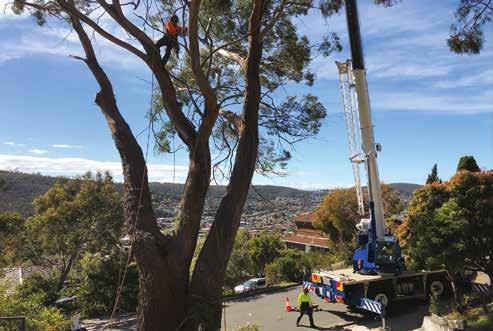


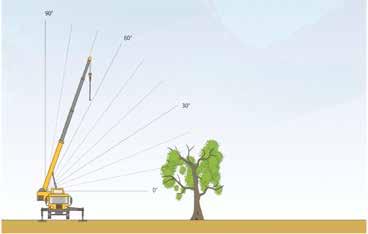
“With a crane, you want to remove the top branches first. This is because you will need to drop the hook of the crane above the branch and lift it up to remove. Then, you will step your way down the tree so you’re removing the lowest branches last.
“Even if you have a crane on site, it might be preferable for you to start the job using traditional climbing techniques, particularly to clear out the bottom of the tree for your lowering zone,” Joe says.
To find out more about Vermeer Australia, including more information on the Vermeer Australia Arborist Seminar Series, head to www.vermeeraustralia.com.au AA
“The most fundamental rule when working with cranes and trees is knowing that cranes are designed for a static load.”
We’ve all known people who like a good moan and whinge about anything and everything. Some keep it up for weeks, months, even years on end. You listen, bite your tongue and think: “Well, why don’t you do something about it?” Fortunately, some people do. They try to implement change for the greater good and, with a bit of luck, improve things for themselves and others.
Mona Bruckhoff is keen to do so as a Queensland-based arborist. The 34-yearold is Sunshine Coast representative on the Queensland Arboricultural Association (QAA) committee and keen to help bring about change in a state she says takes a very oldschool approach to tree work.

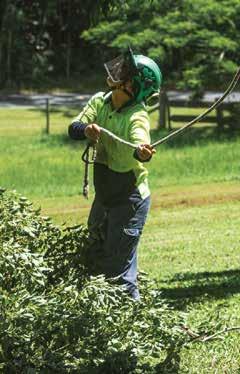
“Joining the QAA meant I’m not just sitting down grumbling about it, but actually doing something about it,” she says. “It’s also helping me learn about the processes out there, why it’s slow and difficult for changes to happen and the issues faced over the years. I’m lucky to learn from people who’ve been in the industry a very long time, plus be part of the new energy the committee wants to build.”
Mona acknowledges the industry won’t change overnight but wants to ensure she’s doing what she can to speed up the process. Better training, better education and a more holistic approach to tree management are key aspects she’s lobbying for.

“There’s a mentality in Queensland that anyone can grab a chainsaw and just cut a tree down, even if it’s not the best practice, and take the cash,” she says. “There are more regulations coming in and that’s great for the industry, but right now it feels there’s very little regulation and anyone can just set up a company. The result is a lot of places undercut each other and fight for money rather than doing the decent work they should be.”
Of the many arborists across Australia

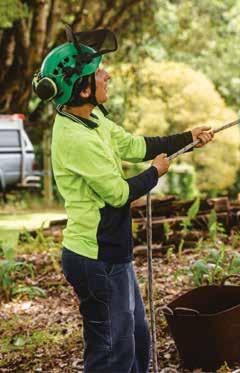




we’ve interviewed, a common thread is the increasing drive towards conservation alongside a more scientific approach to arboriculture. Mona’s degree in zoology with conservation shows she’s well placed to be part of this, backed up by her career working as a ranger for Queensland Parks and Wildlife and for tree care companies both large and small.



At Treesafe Australia she completed her Certificate III in Arboriculture, becoming proficient on working on large trees and bigger machinery. Mona recently started working for Bush and Beach Tree Services in the Sunshine Coast Hinterland, carrying out jobs for private clients across the region as well as councils and schools.
“I’m an all-rounder,” she explains. “I can climb, I’m on the ground, run a crew, drive the trucks and fill in the gaps. I love the outdoor, physical work and that’s something that’s going to be needed in this industry long-term.”
Mona performed strongly at the 2019
“I can climb, I’m on the ground, run a crew, drive the trucks and fill in the gaps.”
Queensland Tree Climbing Competition, winning the female throwline, placing second overall and winning the rookie trophy. Part of her prize included representing Queensland in the Asia Pacific Tree Climbing Championships, but Covid cancelled that opportunity.
“The event was great for networking and learning new skills but going forward I’m happy to concentrate on the more scientific side of things,” she says. “It was powerful to do it with other women all supporting each other. There’s solidarity there as women have gone through struggles in this industry, and to talk to women who’ve been able to help create a path for me and others has been really powerful. They’d have found it tougher than me before.”
Keen to become an AQF Level 5 arborist, Mona says opportunities to do so in Queensland are limited so is looking to find a course in VIC or NSW and study online. “Sadly, I feel in Queensland it’s more about the money rather than the education,” she explains. “I was disappointed with the
Certificate III course I did. It was tick and flick really. I wanted it to be better and more engaging, so I’m grateful to be part of the QAA community now. They’re putting on more workshops and online learning.”
Mona’s keen to incorporate her science degree into her future studies and work. In her experience, the scientific side of arboriculture has been too often overlooked. “Exploring the scientific research on fungi with trees; the soil around them; how trees grow in urban areas and how to create habitat trees, it’s all engaging stuff that’s much more than just pruning or removing,” she says.
“Changing the language we use would be helpful too; I don’t think ‘tree lopping’ is okay anymore. Another term for arborists is ‘tree doctors’ but we’re rarely treated that way. You don’t go to a doctor’s surgery and suggest what’s needed, but that’s what happens when the client thinks they know what’s safest or best. The problem here is if conservation is the best option but the client
wants a tree cut down, if an arborist doesn’t do so another will and take the money for the job.”

Mona looks to NSW, Victoria and overseas as better regulated places for professional arborists to operate, and says she still loves her work and encountering others in the industry keen on change, increasingly holistic approaches and embracing science.
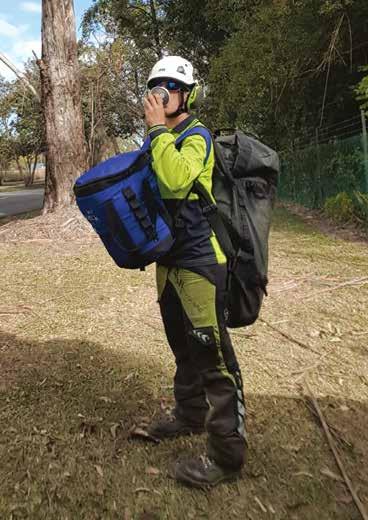
She enjoys the physical nature of the work that helped bring her to arboriculture and says she’s mindful of how she works and how best to use modern equipment. “I enjoy working outdoors and with nature. Keeping fit is a bonus but I have noticed how others who have been in the industry for longer have so many injuries. I work hard but want to incorporate new techniques and machinery to support my body to be able to continue the work for a long time.”
Working smarter rather than harder? If science can help do so then all arborists should ultimately benefit. AA

 Husqvarna’s new 592 XP® Designed for a better cutting experience.
January 2021, Sydney, NSW Australia
Husqvarna’s new 592 XP® Designed for a better cutting experience.
January 2021, Sydney, NSW Australia
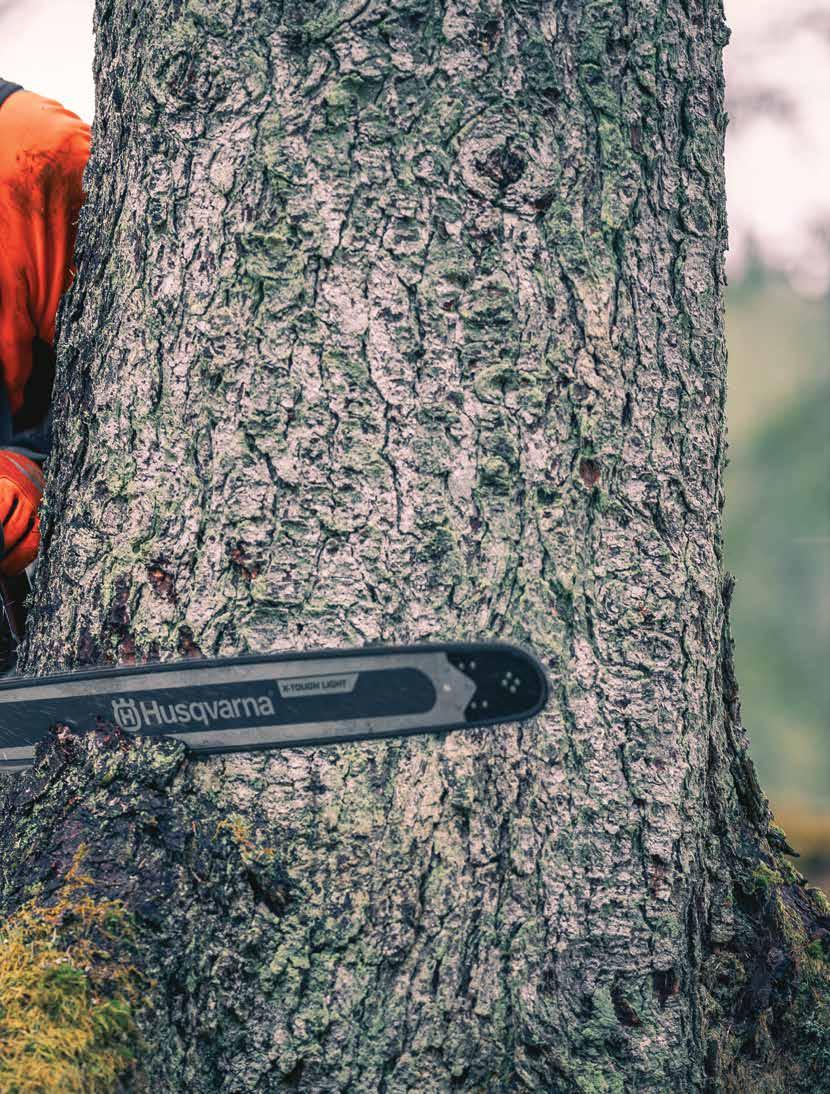
The
decision
Tree Care WA have been one of the leading tree arboriculture companies in Western Australia for over 30 years. And Bandit has been right beside this proud Perth business for 15 of those years, supplying quality machines and service, the latest addition being six new chippers added to the Tree Care WA fleet.
“Through years and years of working with Jesse and the Bandit team, their service, reliability, parts and turnaround times are second to none,” says Joseph Versaci, Operations Manager at Tree Care WA.

“We’re stoked to be working with Bandit, we’ve got a great fleet and we’re looking forward to getting into it.”

commercial, civil, mining industries and government departments across the state.
The company is now expanding its fleet with six new chippers: two Bandit 15XPC’s and three Bandit 18XP’s which arrived in November last year, along with one Bandit 18HD on its way to Perth.
These machines will be joining a number of Bandit machinery already operating with Tree Care WA, including a 1680 Horizontal grinder and HB20SP stump grinder.
Asked about the update of their fleet, Allana Tyler, General Manager at Tree Care WA, said: “We recently sold the Bandit 990 wood chipper, which was in our fleet for around 10 years. It had proven to be one of the most durable, versatile chippers we owned.”
“Many of our employees were sad to see
this unit go due to its durability and it was really user friendly to operate and maintain. The 1680 horizontal grinder is still in our fleet and we hope it remains that way for the near future.”
After discussion with her team last year, Allana says there were a number of factors in choosing Bandit for the upgraded Tree Care WA fleet.
“The Bandit customer service and aftersales support was a major factor. In addition, the robust nature and dependability of the machines. The machine operators are praising them (the new chippers) instantly, which is fantastic,” says Allana.
“Jesse at Bandit’s Perth branch provides an exceptional customer service experience, he is always available to provide after-sales support, including training and any repair assistance.”
All six of the new chippers include as standard Bandit’s hydraulic lift and crush system which helps feed very difficult material. They also come with the hydraulic winch system to help drag in heavy trees safely and quickly. Each of the new Bandits vary in size and output:
• Bandit 15XPC – 15 inch capacity with CAT 142hp engine
• Bandit 18XP – 18 inch capacity with CAT 142hp engine
• Bandit 18HD – 18 inch capacity with Cummins 185hp engine
The specs and features on these new chippers will be a key part of increasing Tree Care WA’s productivity on its sites around Western Australia.
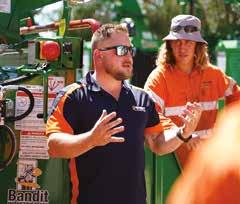
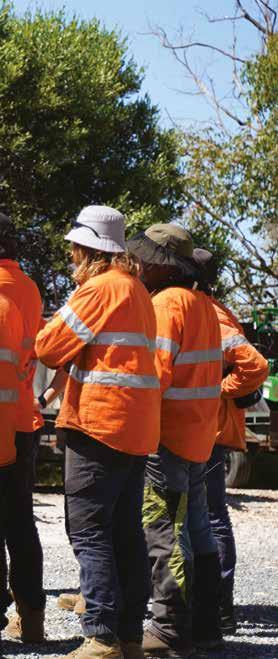
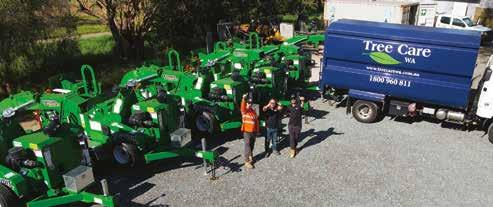
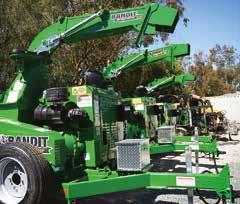
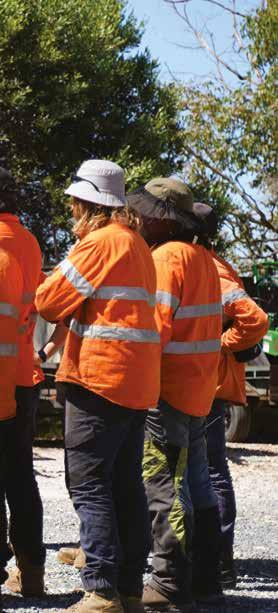
“They’re a lighter overall machine. They have the additional safety feature of a secondary shear bar,” says Allana.
“They also have a better set-up for machine feeding, and a simpler process to locate and diagnose faults.
“We have multiple LGA contracts and various government contracts that they will be utilised throughout. We also cover the civil and commercial market here in WA, which we are really excited to have the Bandit 18XP on.”
Visit www.banditchippers.com.au and www.treecarewa.com.au for more info. AA
“Jesse at Bandit’s Perth branch provides an exceptional customer service experience.”
The company took its present form after permanently relocating from the United Kingdom in 2018, gradually re-entering into the Australian market.
Grandview Gardens QLD is a family-owned business, predominantly covering western suburbs of Brisbane, Queensland.
Michael Rudd, proprietor says: “Our business vision has always been rather unique in comparison to many other businesses out there, with a focus on gaps in the market and new ways of achieving superior results. That’s where the beginnings of our relationship with Monitor Lifts started.
Having used spider lifts in the UK we always knew that this was the way forward for us. After a rocky start of trying to purchase one, we managed to secure our spider lift from Monitor at the beginning of 2021. The benefits of owning and using one daily outweighed the financial commitment and we never looked back. Take it this way, our beloved spider lift is like a designer handbag. You want to take it everywhere and never leave it at home. So it goes with us and we make sure we utilise it to its full potential. In fact, we make our jobs fit around the spiderlift so we have to use it. How we survived
without one is now unimaginable.
“We purchased the PB 1575 Electric/Petrol powered narrow access EWP mounted on crawler tracks. The customer care from the Sydney team and now the team in sunny Brisbane has been always exceptional. There is always somebody available on the phone, with courteous attitude and willingness to assist. From the sales team, the accounts department through to the service team, we get flawless and attentive wrapped around care. This has been invaluable particularly with the complexity of the machine and too many questions we had at the very beginning.

“Our spider lift now wrapped in our company graphics is a head turner. Not many companies own one around here and we have noticed that particularly the female customer base is more than delighted and rather envious. I think we had around three clients dreaming of purchasing one in the future.
“It is worth mentioning that educating our clients takes a bit of time as not many are familiar with the set up and the use. We tend to show photos and videos and explain until the D-day when the customers fall in love with the precise pruning works, sharp hedging and accessing inaccessible areas. Over the past six months we have noticed increase in customer base requesting a cherry picker to be used for their works, so certainly a bit of educational stance and perseverance helps.
“Our spider lift has multiple benefits. We
predominantly run it on the batteries and recharge it at the end of each working day. This ensures a quiet operation which is a customer-pleaser, particular since Covid started, as many people are now working from home. We are able to access the very tips of trees and prune precisely in line with Australian and arboricultural standards, rather than “lop off” as we can’t reach any further. We pride ourselves on our professionalism, and having a spider lift fits in with our egos well.
“Would I buy another one again? Yes! We would and we will upgrade in the future. We don’t just use our spider lift for tree work; we access gutters, help tradies to hang air conditioning units, install swings for children and fit wildlife boxes. I cannot recommend the purchase enough. Having reliable and safe equipment is part of our success I guess, and with a company such as Monitor Lifts that respond as they do, this makes our work life much more enjoyable.”

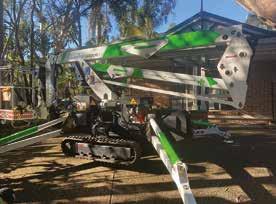

For more information visit www.grandview-gardens.com.au and https://monitor.net.au

CJ & LH Wiesner’s, importers and distributors for Timberwolf wood chippers for Australia received their first container load of machines from the UK just a year ago.

We have faced shipping delays, Covid-19 travel restrictions and lockdowns.
But the dedicated staff at CJ & LH Wiesner’s and the reputation that Timberwolf chippers have overseas means that they now have Timberwolf wood chippers operating from the south coast of Victoria and into Southern NSW. Wiesner’s and Timberwolf continue to grow in partnership with their customers.
The first of those customers was Beaver Tooth Chipping of Porepunkah, Victoria
who purchased a Timberwolf 280TDHB

8" Kubota diesel powered, road tow machine. Beaver Tooth Chipping owner, Steve Lebrun, was immediately drawn to the build quality of the Timberwolf and the dual in-feed rollers ability to feed bushy, brashy material, something his previous, single roller machine struggled with. Steve said: “Wiesner’s are great to deal with.
The staff are always helpful and happy to answer my questions. The sales process was easy and they even helped me sell my old chipper.” Steve put his Timberwolf


280TDHB straight to work and within half an hour he informed us it was “Outperforming expectations” and further commented: “This thing is a beast.” He also confirmed that the 8" Timberwolf 280TDHB was out chipping larger competitor machines. On the subject of size Steve has been able to take advantage of the Timberwolf’s high capacity, low towing weight and small size to get into places and carry out jobs that competitors with larger machines have been unable to do.

Having completed 300 hours work Steve knows he made the right decision with the Timberwolf saying: “The aftersales service from Wiesner’s has been second to none. They keep most parts in stock and have always worked with me to get my servicing done at times when it suits me.”
Check out @beavertoothchipping on Instagram to see Steve’s machine in action.
If you would like more info or are interested in a demonstration, please give Simon a call at Wiesner’s on 0477 885 922. AA
Directors are versatile, compact, termination connectors. Strong yet lightweight, the Directors use DMM shortest gate to maximise gate opening and clearance. Directional design loads the connector in the strongest orientation and the ‘Rhino’ horn stops devices loading on the spine.
Perfect on lanyards or when used in conjunction with Linkits, as part of pre-configured assemblies to reduce the length of systems. The Yoke and Swivel Boss versions can also be interlinked with each other to form a double connector that swivels and pivots.




Patented and Pat.
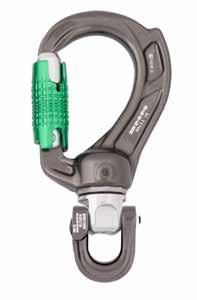
The city park may be an artificial ecosystem but it plays a key role in the environment and our health, the first global assessment of the microbiome in city parks has found.
The study, published in Science Advances, found that even roadside verges contribute a range of important microbial communities that are critical for sustaining productive ecosystem services, such as filtering pollutants and sequestering carbon dioxide.
“Parks are not the homogenised ecological deserts that we think they are – they are living ecosystems that do amazing things,” study co-author, Professor David Eldridge from the Centre for Ecosystem Science in UNSW Science’s School of Biological, Earth and Environmental Sciences says.
“Urban greenspaces harbour important microbes, so if you want to sustain a bunch of ecosystem services, you need to have plenty of parks and green spaces.”
The study took soil samples from different type of urban green spaces and comparable
neighbouring natural ecosystems in 56 cities from 17 countries across six continents.
The urban greenspaces studied included Olympic Park in Beijing, the University of Queensland campus in Brisbane, Retiro in Madrid Spain, and the park surrounding Uppsala Castle in Uppsala, Sweden.
With 68 per cent of the global population set to live in cities by 2050, the study suggests that urban green spaces are critically important for promoting mental and physical wellbeing.


Parks and gardens make up most of the open spaces available for recreational activities such as sport and social engagement, and play important roles in curbing pollution, reducing noise, and lowering air temperatures, the study says. Moreover, human exposure to soil microbes has been shown to be beneficial to human health by promoting effective immunoregulation functions and reducing allergies.
The study found green spaces support
many fast-growing microbes that use fertilisers and irrigation water, and that can colonise bare soils. These included important fungal root pathogens such as Fusarium, microorganisms capable of removing nitrogen from sewerage, and many bacteriafeeding amoebae.
But the study found that green spaces also harboured a greater proportion of fungal parasites and plant pathogens that are often economically important pests.
Green spaces in some countries also host microbes that were linked to human pathogens, such as listeria and diphtheria.
“The really interesting thing is that there was a strong link between a country’s Gross Domestic Product and the abundance of the microbes that caused human diseases,” Prof. Eldridge says. “One of the reasons could be a greater use of antibiotics in developing nations, and therefore greater microbe controlled antibiotic resistance. Sewerage water containing antibiotics is then used to water greenspaces. So, while parks
are good, there is a warning that some of the soil in these urban green spaces do harbour some of these toxic microbes, particularly in poorer cities.”

Dr Eldridge says the results mirror a study in Central Park in New York, which found there was as much microbial diversity in the city park as there is globally.
“City parks harbour a range of microbial communities that are different to natural ecosystems,” he says. The study found that even road verges were full of important microbes. “We think of roadsides as being barren, but we found a great variety of different microbes in some roadside verges; they are not barren wastelands at all,” Prof. Eldridge says. “Some European cities such as Bern in Switzerland have a policy to protect the natural vegetation along footpaths and roadsides. These pathways then become mini-green spaces, linking larger green spaces. We need lots of different microbes, and to get this, we need a variety of landscapes such as median
strips, parks, and nature reserves.”

Lead author Dr Manu Delgado-Baquerizo from the Universidad Pablo de Olavide in Spain says the study found that urban green spaces from all over the world are very similar. “They often have lawns, and similar management practices, which tend to homogenize the microbes living in different
global cities,” Dr Delgado-Baquerizo says. The international study is part of a series of research looking at the importance of green spaces for ecosystem health. The next study will examine the importance of mosses in urban green spaces for supporting healthy soils and important habitat for microbes. AA

It is time to double down on those things that are working for you. The more you focus on something the more results you will see from it.
Scale up the advertising in the areas that you have identified as bringing in the clients and projects that make you good money.
• Prioritise the quotes that you have a bigger chance of winning. Put the high-profit jobs at the top of the list
• Promote and encourage staff who are working well for you. Empower them to spread your company culture
• Look for more staff who align with the company culture you want to have.
The three months leading up to Christmas and the Summer break have been brutal. You’ve worked your bum off and pushed your crew to the limit to meet the Christmas workload. Congratulations, you got through it!
Now it’s time to set your business goals. Here are some tips to help you set meaningful goals that will ensure you have your best year yet!

The first thing you need to do is take a good, hard look at last year. You need to ask yourself these questions so that you can plan 2022 with clarity. Identify:
• What work made you the biggest profit margin – why?
• What work cost you the most money – find out the reasons why.
• What type of jobs did you price, time and again, and not win – why?
• Where did your good clients come from?
• What advertising strategies worked?
• The staff who are working well for you and
the staff who are costing you money
• What parts of the business are costing money due to communication and lack of procedures?
• What practices you, yourself are doing that are jeopardising your business?
• Your company culture. Is it where you want it to be?
Take emotion out of it. Spend some time to run the numbers to answer these questions without bias, you may be surprised by the answers
Now it is time to stop doing what is not working for you. Stop:
• Spending money on advertising that attracts the wrong clients
• Pricing projects that you have very little chance of winning
• Giving work to staff who are costing you money. It is time to let them go
• Doing ‘XYZ’ that is jeopardising your business.
Now it’s time to start some new habits. Spend some time to identify new strategies that you think will have a positive impact on your business. This is a good time to think outside the box and set goals that are experimental, pushing the envelope may lead to a big breakthrough.
• Clients – If there is a new type of client you want to work for, identify them and set a plan in place to start winning work from them.
• Work – If you want a reputation for doing ‘XYZ’ work, then you need to actively set out to find and win that work. Put a plan in place to start winning more of that work and before long you will have a decent portfolio of it.
• Advertising – Identify new ways to advertise to attract the clients and work you want to attract. Don’t leave it up to chance, when you are proactive you are in control.
It is time to implement new habits that will strengthen your business. Policies and
It’s time to set your goals to make 2022 a bigger and better year.
procedures are a good way to clarify a new process. Pick one that you want to ‘fix’, write a policy and focus on making it a habit within the business.
There is no point spending a week working on your business goals if you don’t keep track of their success. Once your goals are in place you need to set deadlines for achieving them. Just like setting KPIs for staff, turn your business goals into your own KPIs. Assess these goals as required throughout the year. The best thing to do set targets for each goal and map them on a calendar.
Along with setting your business goals, it is a good time to take stock of the everyday resources to ensure they’re up to date and still valid:
• Are they costing you more than last year?
Are you meeting the award?
• Now is a good time to increase your charge out rate.
– are you getting the best deals?
• Review your terms and conditions – are they still valid?
• Review your office expenditure
• Is your office efficient? Do you need a bigger/different space? Is the printer subscription worth it now you have gone paperless? Is your software doing the job? Is your accountant still working well for you?
• Preview policies and procedures – do any need to change?
• Review employment contracts and conduct performance reviews and set KPIs for the year
Do an inventory of your machinery, equipment and materials.



Conducting a full audit of your business and setting goals for the year ahead is not a 5-minute job, but it will set you up for a much more successful year. Spend the time to dive deep into the numbers and be honest with yourself about the results. 2022 has every chance to be a bigger and better year than 2021 (let’s face it, that wouldn’t actually be hard!), so don’t miss the opportunity to knock it out of the park! AA
Designed & manufactured in NZ with local parts & servicing available throughout Australia. 250 hour service intervals, double sized blades and supreme performance for happy customers.
Small business owners tend to be born optimists with little inclination to think about what could go wrong. That’s why it pays to have an insurance broker in your corner to safeguard what you’ve worked for.
Anyone who has compared car, home or health insurance policies to try to find the best deal knows how time consuming it can be. Choosing a business insurance package is even more complex because of the range of risks requiring cover.

A broker will not only save you time sourcing the right policy, they can also save time and money if you need to make a claim. That was Harrison’s recent experience with his long standing Steadfast insurance broker.
Utilise your broker’s experience
Small business owners are great at what they do, whether it’s running a café or a consultancy. But they are rarely insurance experts. What they may not understand is the broad range of risks they face.
A broker will help identify the risks your business faces, then get the insurance package that matches those risks. “There’s no point buying a business package off the shelf if it only covers some of your risks.”
I don’t think you can do that on your own. You may think you know what can go wrong but you never realise how much impacts on your business going forward.
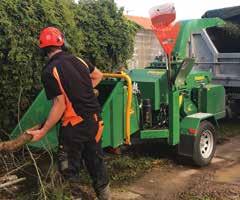
Access better deals and cover
Buying the wrong insurance cover cheaply can be expensive, whereas paying a bit more for the right cover can save you money. In some instances, an insurance broker may even be able to negotiate a better deal in terms of both price and coverage. A broker will find the business package that covers their client’s risks at the best value for money.
Harrison says his broker also keeps the business up to date when new policies become available and advises them when their assets need upgrading. “The first time we made a claim, we didn’t have computers. They said a computer stock take would make future claims easier, so we installed computers with software to substantiate claims quicker. If you have to make a claim, it’s good to have someone on your side.”
Back-up when you need it
Your insurance broker works for you, not the insurer. A good broker can prove invaluable if a claim needs to be made, by co-ordinating the claims process and knowing what is and isn’t covered by your policy.
Behind every Steadfast insurance broker is the power and wealth of knowledge of
the Steadfast Group. If
Steadfast Group
of the claim, if there are grounds to go in and provide additional strength. “If you have to make a claim, it’s good to have someone on your side,” says Booth.

It’s worth investing some time and effort into finding an insurance broker with a good

reputation. One who you trust and are happy to have a long-term relationship with. “As you grow, they grow with you”, says Harrison.
The information provided here is general advice only and has been prepared without taking into account your objectives, financial situation or needs – Fitzpatrick & Co.

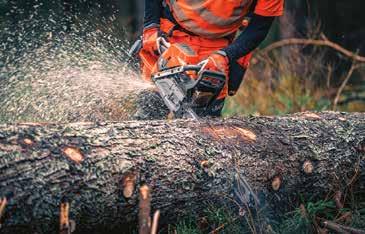
Insurance Brokers Pty Ltd (ABN: 25 050 242 914, AFSL No.: 244386).
8544 1600. AA
“Your insurance broker works for you, not the insurer. A good broker can prove invaluable if a claim needs to be made.”
Timing and taking the initiative can be everything when running a business, and it is important to maintain momentum by making strategic decisions and implementing changes when required, bolstering your day-to-day operations and creating a clear path to growth.
Businesses may actively seek to alter their structure and operations, or may have change thrust upon them, and flexibility is often a key component in successfully dealing with a combination of internal and external factors.
Of course, arborists will typically need to navigate a range of short and longterm challenges, from staffing issues and skills shortages, through to equipment investments and the adoption of new technologies, underpinning efficient and effective operations.


As the past two years in particular have shown, the unexpected can happen, and for this reason it is important to plan ahead, ensuring that a strong business foundation is in place, while also being prepared to adapt when required.
Of course, each business is unique, and it is important to carefully consider the range of individual factors impacting your business in determining the best path forward.
Some of the main challenges and drivers for business change, faced by those in the industry include:
• Skills shortages – finding and then holding on to appropriately skilled employees presents an ongoing challenge for industry
• Workplace health and safety – is a critical issue for industry, with the COVID-19 pandemic bringing about a range of additional considerations
• Equipment investment – knowing when to invest and ensuring you get the best deal for your business
• Technology adoption – different facets of business operations continue to go digital, from administration to advertising, providing efficiency gains
Across each of these different areas, businesses can take steps to bolster their operations, and it is important to adopt a forward-looking outlook.
For instance, as those within industry have previously told AA, creating a workplace with a degree of staff flexibility, in which a clear career path is laid out for employees, is important, while a strong workplace health and safety culture can facilitate trust and contribute to a productive working environment.
Meanwhile, it is important to clearly establish your business needs and capabilities when investing in equipment, consulting with financial professionals when required, and to consider how digital technologies can be incorporated across, and streamline, your operations.
The business.gov.au website describes change as being “a normal and essential part of business”, with it being an important step for businesses to improve staff performance, enhance goods or services and to expand.
As part of the process of creating an effective change management approach, business.gov.au outlines the following four steps:
• A clear picture – starting with a clear picture of your desired outcome can help people understand the bigger picture, keeping in mind what they’re working towards
• A change management plan –writing down business changes can help business owners document and communicate their plan, encompassing: their desired outcome; the change’s reasons, benefits and aim; who will
undertake necessary tasks; goals, targets and potential milestones
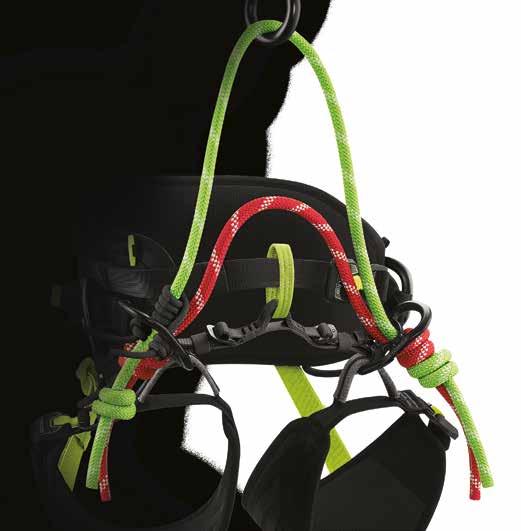
• Keep staff up to speed – proactive communication and engagement can help people understand and embrace the change, with it important to communicate openly and directly with employees, to make them aware of the change as soon as possible, and to involve staff and support them
• Change culture – promoting a culture of change, encouraging and recognising staff engagement, and continuing to look for ways to improve a business, can help staff become comfortable with change and adapt easier in the future.
Further information on managing change and how to be proactive in promoting a culture of change with your staff can be found at the business.gov.au website. AA

Waimea can even supply units up to 20m working height on a car licence category truck.

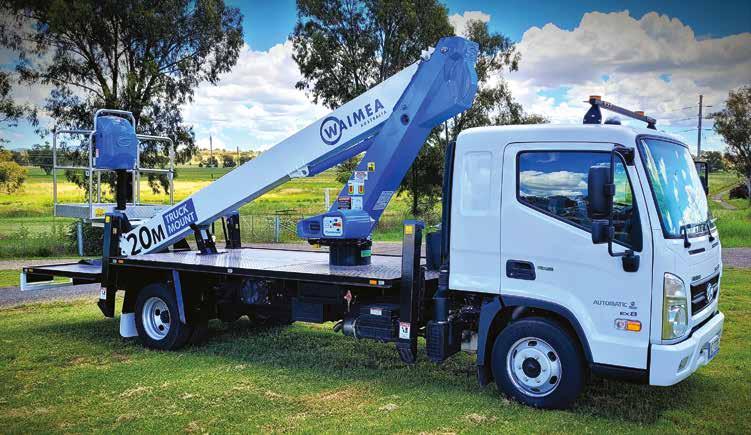
Truck mounted EWPs can be advantageous when doing repetitive street tree maintenance or projects requiring long distance travel. Especially being a registered road going vehicle, this can prevent any hassle with traffic management or permits. A small unit such as the Waimea E209PX is very compact and takes up a lot less room than a vehicle towing a trailer. Setting up is very fast; simply pull up, engage the PTO, climb out of the vehicle and lower the stabiliser legs and you’re right to elevate.
The Waimea Australia truck mount designs are very compact, allowing for tight access and efficient operation. There are telescopic and knuckle models available to suit any requirement. The clever doubleknuckle boom design of the Waimea units (20m, 25m, 29m and 36m models) provides an excellent working envelope, from ground level right through to working height, with very minimal tail swing. The full safe working load is available throughout the entire envelope providing unrestricted outreach.
The vertical heavy duty stabiliser legs allow the truck to set up on all sorts of terrain and provide a very nice sturdy base to ensure excellent stability at height. The stabiliser legs
do not protrude past the edge of the truck tray, allowing setup in very confined areas and within one lane width if doing street work.
Smooth hydraulic controls allow very precise operation, and also provide for fast boom movements when required. Multiple functions can be made simultaneously. Platform rotation is standard, and fly jibs are available on some models.
Waimea Australia can even provide radio control options, auto level, custom tool box design, roof and cab protection, etc. Step aboard and be ready to hit the road for the next project.
For more information on the Waimea Australia products, please call the friendly team today on (02) 8610 5601 or email trucks@waimea.net.au. Whether it’s sales or hire, or Hire 2 Own, Waimea Australia is sure to have an option to suit your needs. They stand by their reputation to provide you with Optimum Lifecycle Performance.
Tree Radar Australia uses a ground penetrating Radar Unit to provide the only, completely non-invasive method of tree decay detection and tree root detection available in Australia.

Tree Decay is a severe problem which can put all the structure around a tree at risk. With Tree Radar Units™ decay detection, Tree Radar can scan for decay in any tree regardless of its height. The Tree Radar unit can give an accurate read out of the severity of decay in a tree without having to penetrate the Tree’s surface.
Tree Radar Unit™ can detect and establish the root proliferation of a tree, this allows the arborist to inform developers of any structural or instability issues without the need for drilling or digging.

Every new Först wood chipper comes with a three-year warranty. It’s all about making your life and job easy, that’s just what the three-year warranty is designed to do, giving you an excellent product and an outstanding warranty to make your purchase decision as straightforward as possible.


The ST6P is a genuine, hardy, performance tool; building on the Först reputation of jaw-dropping performance and robust, tough construction.
The ST6P hosts the powerful and highly efficient Vanguard 37HP V-Twin petrol engine, a perfect match for the machine capacity making it a rapid-fire yet extremely fuel-efficient machine thanks to the electronic fuel injection (EFI) technology.
FörstGrip feed roller system
Twin hydraulic horizontal feed roller system offering exceptional grip on timber. The large top feed lifts on an arc, climbing toward the timber rather than lifting straight up and down, this makes climbing butt ends exceptional. High tension due to twin heavy duty springs and a large bearings supporting either side of the top feed roller ensures strength and durability.
AutoIntelligence is a simple yet advanced electrical control system taking care of all the electrics on the machine. Historically, electrics on plant machinery are troublesome – AutoIntelligence overcomes this with a completely water and vibration proof system designed and tested in the toughest environments.
This system gives excellent usability and outstanding reliability, it will also make you aware when servicing is due and will recommend routine maintenance.


The Först XR8D Traxion Wood Chipper has exceptional chipping performance delivered by a 55hp Doosan diesel engine.

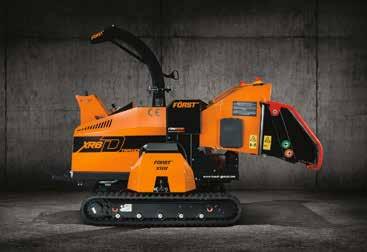
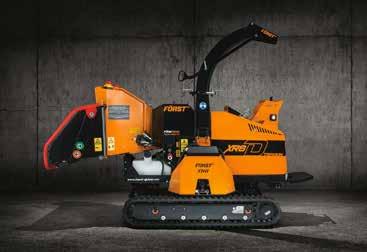

Coupled with the new Traxion embankment system, this machine is rock solid and unbelievably stable on banks up to 35 degrees. This machine not only wins when it comes to ability to grip and remain stable on the bank, it has class leading ground clearance too which makes it all the easier for passing over rough terrain. Direct drive hydraulics taken straight off the engine means this machine has amazing torque and tracking ability on the bank side, it is fast too, getting you to the worksite quicker.
You will love the design of this machine and how easy it is to service and maintenance.


The tracked chippers this size are new and exciting products for Global Machinery Sales. They see a huge potential market for them. With a trailer designed for the machine you could work off the trailer like a normal wheeled chipper, or if you needed to take it round the back of a property, not a problem, the tracked chippers can safely traverse inclines up to 20 degrees.
Demo a Först today, and if you choose to buy an oppositionlike machine we’ll give you $500.
For more information call the team at Global Machinery Sales on 1300 072 926 or visit globalmachinerysales.com.au

CMC Spider Lifts are taking the Australian market by storm. All models are Australian Design Verified and ready to work.
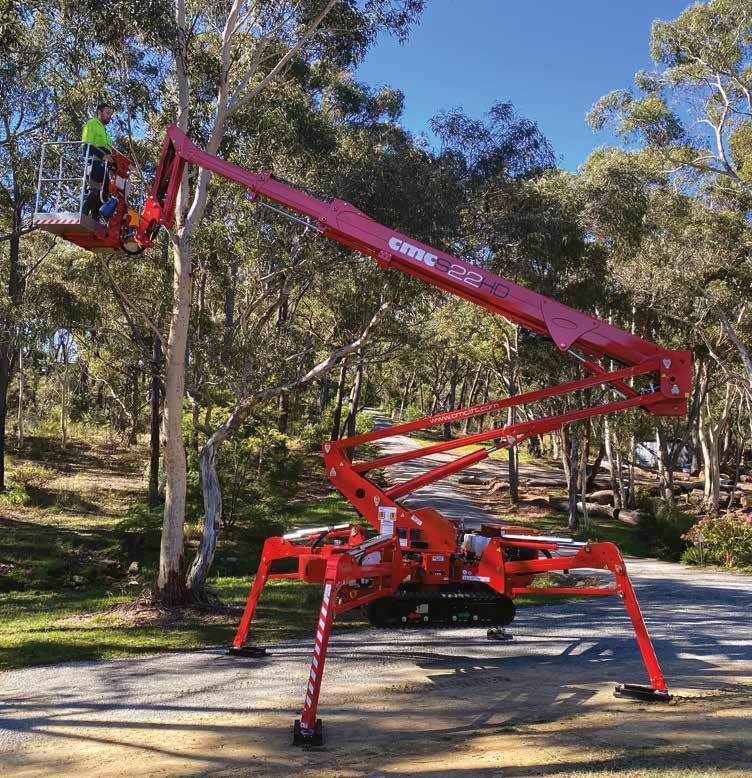
CMC Aerial Platforms offer a range of compact and highly manoeuvrable spider lifts as well heavy duty spider lifts with big height and reach. The CMC spider lifts that Global Machinery Sales stock for the Australian market range from 13 metres in height through to 41 metres. Each lift has an impressive outreach, powerful engine and large basket capacity. The team at Global Machinery Sales have worked diligently with top EWP dealers in America and Europe to bring you the world renowned leader.
The CMC S22HD is an articulated platform with a pantograph and a two-stage telescopic boom plus jib. This combination, together with its outriggers of high levelling capacity, three working areas and long horizontal reach, makes it ideal for all outdoor works, even in extreme conditions. The JIB completes and increases the potential of the HD range. To the potential of the articulated stabilisers with high levelling capacities, 21.6 metres of maximum working height and 12.50 metres of outreach plus Jib for a maximum load capacity of 230 kg.
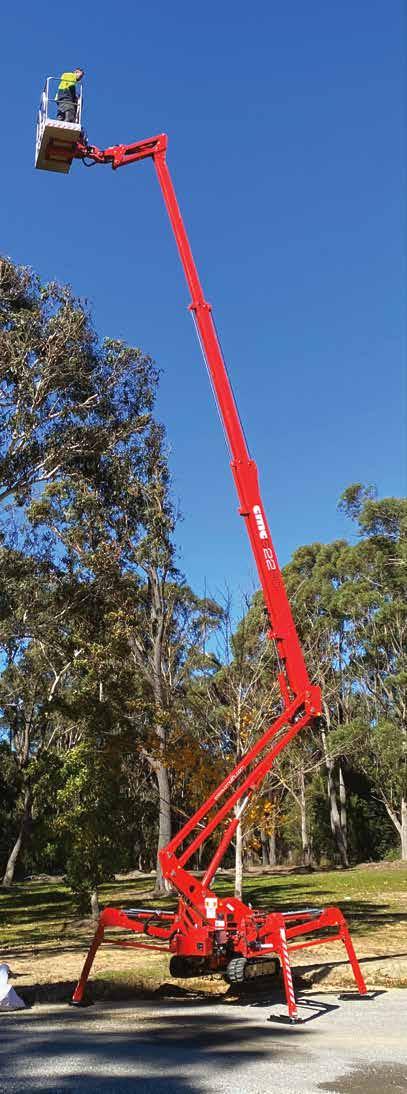
Thanks to the three working areas and the multiple travel speeds, the S22HD is a track platform with truly exceptional performance, suitable for every job.
For more information call the team at Global Machinery Sales on 1300 072 926 or visit globalmachinerysales.com.au AA
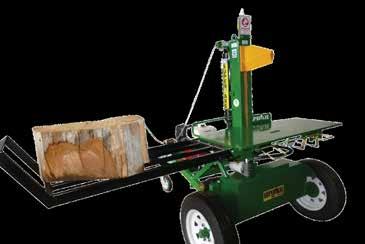

After moving into a new 2,500m2 purpose-built facility back in 2019, Hansa has recently completed works which has doubled their manufacturing space at their global headquarters in New Zealand to meet their customers’ appetite for quality chippers.

Originally, the factory expansion was a 5-10 year plan but with sales exceeding expectations in Australia, Hansa’s decision to bring forward the expansion was essential for continued growth and development of future products.
At the time of building the new headquarters Hansa’s Managing Director, Martin Vogel, knew the land was much larger than required but he could foresee the need to invest for the long-term future of the company.
As part of factory expansion, 290 solar panels have been added to the roof of the extension to provide 100kW of power, this compliments the Lean manufacturing
initiatives to minimise waste through all areas of the business. The expansion is another continuous improvement towards actualising their sustainable initiatives on premises.
Concepts are underway for a semiautomated powder coating line. Once implemented, the new semi-automatic line will complement the existing robot welding, and powder-coating facilities to efficiently produce more product in less time.
Keeping things local is a driver for Martin and says, sending production offshore would take all the satisfaction out of what they do and impede their ability to continually improve their products.
“From a manufacturing perspective, our production allows us to make continuous rapid improvement. We have our process set up to give us an edge on the competitive market. And being able to maintain quality control inhouse, you can’t achieve that offshore.”
With the boom Hansa has experienced it
was also time to relocate to a new, bigger and better Australian warehouse. Located just north of Brisbane at 1/16 Piper Street, Caboolture and with nearly double the space of the old warehouse, Hansa can stock more parts and machines to service and support the local Australian market.

60 per cent of Hansa’s products are sold in Australia, there’s no surprise that the company continues to invest locally. This is only the beginning, there are plans for further expansion around the country.
One of Hansa’s most popular machines saw an even bigger demand over the past two years due to its ease of use on difficult sites with narrow access or soft ground conditions. The Hansa C65RX is always up for a challenge in rough terrains as the toughest tracked chipper in the industry.

The C65RX has all the bells and whistles that a serious arborist is after. With safety being the most important factor when on site, the rubber tracked driver on the C65RX is operated by a fully proportional remote control, removing the operator from the danger zone. The remote allows the operator to navigate the 64hp machine in the most difficult areas from a safe distance.
The powerful hydraulic feed system makes it easy to process any material. Its wide feed opening (18" x 10") means bushy, twisted branches with forks are pulled into the machine without effort. With the 360° rotating outlet chute the discharge direction can be changed within seconds.
If you’re looking for a quality chipper, then you want it to last a lifetime, and that’s exactly what Hansa aims to do.
For more info freephone 1800 426 722 or call www.hansaproducts.com.au
Hansa has seen a huge increase in demand for their range of chippers in Australia and New Zealand as well as other export markets around the world.
Supplying all of Brisbane’s arbor, forestry, access and landscaping industries with quality commercial wood chippers, stump grinders, forestry mowers and spider lifts, from leading brands such as Morbark, Rayco, CMC and Först.



Need to hire a machine? Global Machinery Sales has a wide range of machinery available for rental. If you need a bigger chipper for a contracted job, or need a spider lift to safely complete a job, all their machines are available for rent. You will also be able to try their brands before you purchase them.
The team at Global Machinery Sales have you covered with a workshop and spare parts department that is focused on the highest quality and a fast turnaround on all repair work. If your repair needs are urgent, trust only Global Machinery Sales with your servicing requirements. The parts department at Global Machinery Sales stocks all the necessary parts for all your repairs and servicing needs.
For more information please call the team at Global Machinery Sales on 1300 072 926 or visit globalmachinerysales.com.au AA

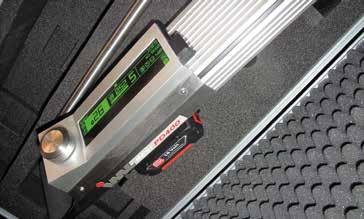
QAA – Celebrating 30 years in 2022.
2022 marks thirty years since a simple, “yeah, let’s do it” on a phone call started the Queensland Arboricultural Association (QAA). We are excited to spend time throughout this year celebrating the people and events that have helped us get to where we are today, while also preparing for the next chapter.

As we move ahead, the Association is looking forward to providing more member benefits and working to increase awareness of significant trees, the environment, and the importance of hiring qualified arborists. The QAA is open to anyone involved in the tree industry. Our aim is to provide information that makes the industry safer and more efficient, all the while providing

continual learning to improve skill sets and quality of work.
With this in mind, we have set a 12-month event calendar to help you better plan and organise your training and skills development. Moving forward the Association would love your thoughts on the things you as a member would like to see or benefit from. If there is a particular event you are passionate about, or you are just keen to lend a hand please reach out to us.
In December the QAA undertook a review of our approved register which includes our existing register members as well as multiple local Councils in Queensland and Northern NSW. We released a survey with the goal of seeking feedback from existing approved contractors and consultants about the effectiveness of the register. We also sought to open discussions with Councils
“If there is a particular event you are passionate about, or you are just keen to lend a hand please reach out to us.”
on their tender process by requesting that it be mandatory for tender applicants to be on the QAA Approved Register. In addition, we offered to provide approved register members with appropriate tender documents to match the application requirements for Councils.
The QAA believes that by making it mandatory for Council tender applicants to be on the Approved Register, businesses who do not possess the required level of qualification, experience, and insurance will not be able to submit underpriced tender applications. As a result, these dangerous businesses will not be able to risk the safety of themselves, their staff and the public while completing council work. This, in turn, will make the industry safer for those working in it while also giving the general public confidence that work is being carried out by accredited and professional businesses.
We thank those who provided feedback during this process. Your input allows us to support the improvement and growth of the register for the future. We are currently collating the data from the survey and will report on the results in a future edition.
When we released our new sponsorship packages last year, we were amazed by the level of interest. Our available packages sold out, with some categories being taken within the first few hours.
Our sponsorship sales for 2022 open in March, and the good news is multiple places are available for new sponsors. As a sponsor of QAA you are helping us give back to our members in many ways, including through reduced ticket prices at events. This allows more members to attend, connect, learn new skills, gain valuable practical experience, and test their climbing ability against others in the industry.
We sincerely thank our 2021 sponsors for their support and look forward to working with you throughout 2022. If you are interested in becoming a QAA sponsor, you can request a Sponsorship Package by emailing office@qaa.net.au.
After the success of our inaugural Business Protection Zone event in 2020, we’re tackling another big issue on Friday 29 April.
Anyone who works within the arboricultural industry is familiar with the current skills gap. Training is expensive, Government funding is limited, and many employers are finding that even if someone has completed their qualifications, their practical experience does not equal the job requirements.
At this community event, we are bringing together people from all sides to discuss this topic. Employers, employees/ contractors, registered training organisations and QAA Industry Support Partners (Fitzpatrick and Co. Insurance Brokers and Vermeer Australia).

There will be two streams of presentations. The first will be from our Industry Support Partners while the second will be from the IPZ Panel.
Some topics covered during the IPZ Panel will include:
• RTOs: Is there enough financial support offered to RTOs to deliver the qualifications appropriately?
• Students: What is it like to receive the training with the current funding and delivery methods?
• Employers: What additional costs are involved in hiring arb staff who do not possess the training and experience required to perform a job?
Rod Morris from the QLD Farmers Federation will be the IPZ Panel Leader. Rod is currently responsible for a project researching how to improve the support and delivery of all arborist qualifications in QLD.
The event will include a fabulous catered lunch and plenty of time for mingling and networking. For further information and to book tickets, visit the Events section on our website.
While we are looking forward to all our events in 2022, our 30-year Gala Dinner on November 19 is shaping up to be something special. This event will be the culmination of our 30-year celebrations and will also see the announcement of a new Lifetime Member. The voting process for this will be announced closer to the event.

Further details will be released as they’re confirmed so be sure to check our Facebook page for information. As an association we’re really excited to share this event with as many of you as possible.
For info call QAA on (07) 3821 1488, email: office@qaa.net.au, or you can go to www.qaa.net.au. Follow us on Facebook (QueenslandArboriculturalAssociation), Twitter (QLD_Arb_Assoc), Instagram (qaa_arborist), LinkedIn (queenslandarboricultural-association)
or via the QAA App. AA

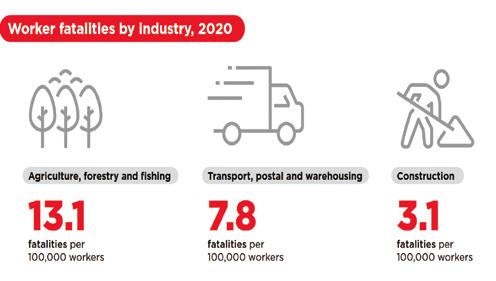
Safe Work Australia has published the ‘Work-related Traumatic Injury Fatalities Australia 2020 report’, which provides the latest detailed national statistics on all workers and bystanders fatally injured at work.
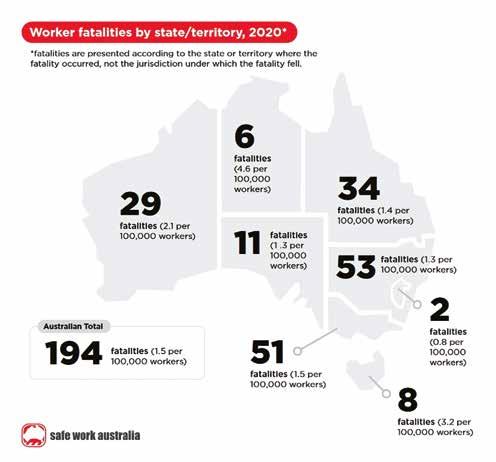
While the rate of work-related fatalities has decreased 25 per cent over the last decade and 50 per cent since 2007, any workplace death is unacceptable.
Tragically, 194 people were fatally injured at work in 2020. Understanding the causes of injury and the industries most affected can help reduce work-related fatalities. The report details that 68 per cent of worker fatalities occurred in the following industries:
• Transport, postal and warehousing (49 fatalities)
• Agriculture, forestry and fishing (46 fatalities)
• Construction (36 fatalities)
The most common causes of worker fatalities were:
• Vehicle collisions (41%)
• Being hit by moving objects (13%)
• Falls from a height (11%)
This report complements and provides additional detail to the ‘Key Work Health and Safety Statistics’ published on October 25, 2021. These statistics should be considered in the broader context of the COVID-19 pandemic when comparing data over previous periods. The potential impact of the COVID-19 pandemic on this data are explored in the ‘COVID-19 and Safe Work Australia data report’.
For more information visit www.safeworkaustralia.gov.au/doc/work-related-traumatic-injury-fatalities-australia-2020 AA




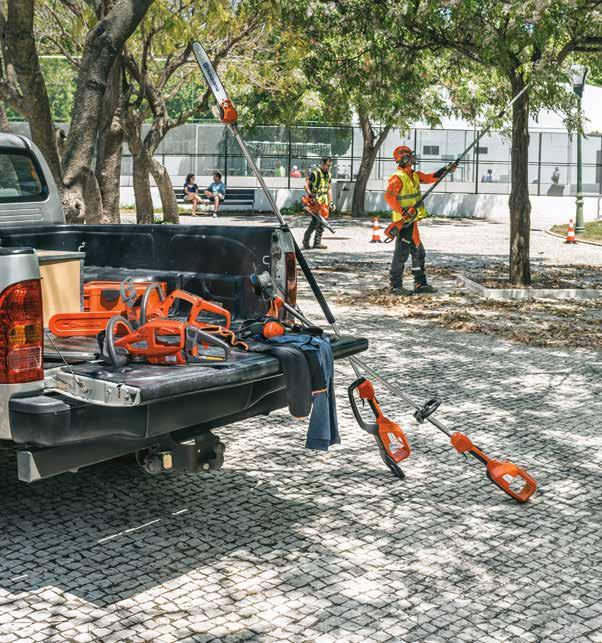
















The IML (https://imlaustralia.com/)
PD-series power drill instrument, commonly called “Resi”, has undergone significant evaluation over the past five years for operational use. The tool can rapidly and quantitatively measure basic density and stiffness in plantationgrown softwoods and hardwoods at low-cost.
Multiple mill trials have favourably compared Resi measurements taken from trees prior to harvest with the quality of actual sawn board product exiting the sawmill.
Non-destructive assessment of wood quality in standing trees has been a research focus of commercial forestry for the past
three decades. Resistance drilling has been part of this, with steady technological improvements over time enhancing the accuracy and operational robustness of the technology. The advantage of Resi to commercial forestry lies in low cost, rapid analysis with acceptable accuracy and precision. A single operator can sample in the order of 500+ trees per day, generating a large amount of quantitative data very quickly (Fig. 1).
Each tree is represented by a radial trace of resistance (torque) measurements at a 0.1mm sampling interval, taking less than 30 secs to collect. Resistance correlates strongly with wood basic density
(Fig. 2). The difference in the anatomy of the trees indicates that the relationship can differ slightly between species and resistance values need to be calibrated by species. Better understanding the physical interactions between wood properties and Resi sampling conditions is a subject of current study.

Generating so much data so quickly raises the need for customised analysis software to extract the various metrics of commercial interest.

Tasmanian-based Forest Quality Pty Ltd, supported by industry partners and Forest and Wood Products Australia (www. fwpa.com.au), has developed web-based analysis software (Fig. 3) to process the large numbers of Resi traces quickly and efficiently. Batches of traces (up to 1500 at a time) can be uploaded, processed and summarised. Various degrees of user interaction are possible to correct or modify individual trace processing as required.
Resi is rapidly gaining traction as a routine forest industry assessment tool allowing for growers and processors to better understand the quality of the forest and how they can be better managed to enhance their value.
For more information email admin@imlaustralasia.com.au or visit https://imlaustralia.com

maintenance events. It’s one less thing to worry about when it comes to machine upkeep.
For instance, under a Cat CVA customers can arrange to have genuine Cat parts delivered according to an agreed schedule, along with clear instructions to ensure that preventative maintenance is carried out accurately.
Having the right CVA in place delivers peace of mind in the event of a machine breakdown, providing expert dealer support quickly – to get customers back up and running and keeping downtime to a minimum.
Equipment that continues to deliver value over the long term is one of the key pillars of productive operations, paving the way for a successful and stress-free ownership experience, and helping ensure machine owners get the maximum return on their initial investment.
Cat CVAs are designed to help customers keep assets in top-notch condition and ultimately help achieve lower ownership costs. The introduction of Cat CVAs to the Australian market has added to the growing suite of aftersales services available from Caterpillar dealers, with plans available for new, used and rental machines.
In fact, Cat CVAs can encompass a variety of plan types. Customers can work with their preferred dealer to select a plan that is in line with specific customer requirements – from
a full-service equipment protection plan, to having maintenance kits delivered for installation. It’s all about helping customers get the most out of a machine.
It is also important to note that Cat CVAs are available for both new and existing customers, and can be purchased at any time, not just at the time of the machine purchase, meaning customers can get in touch with their local Cat dealer at their convenience.
Across the full scope of Cat CVAs, the following are some of the key benefits customers can expect to tap into.
Maintenance support: keep downtime to a minimum Minimal downtime means smooth flowing and productive operations, with Cat CVAs helping machine owners schedule planned
For example, an Equipment Protection Plan (EPP), which may be available with a Cat CVA, provides customers with access to a range of dealer support resources, including troubleshooting and diagnostics assistance, along with repairs for newer machines, using genuine Cat parts.
Along with dealer support, Cat machine owners can secure additional peace of mind via access to a range of digital tools, designed to deliver targeted insights into machine health and operations. Tools such as the Cat app, My.Cat.com and Cat Inspect allow machine owners to take a proactive approach to machine management – such as providing insights into machine hours and locations and allowing for fluid health monitoring – all aimed to help keep a step ahead of potential problems. Be it on site, on the road or in the office, customers can access a range of machine information anywhere and anytime.


Cat CVAs are available for both new and existing customers, covering a range of forestry machines. With a variety of options and flexible elements, the best next step is to work with your Cat dealer. They can talk through the factors that are unique to your operation and recommend the best solution for you based on your needs and type of forestry equipment you wish to cover.

It’s not just protection, it’s an edge to save on repair costs and maximize your machine performance. When you add in the conveniences of delivered parts and a single payment, you get ownership efficiencies like never before. That’s a CVA.
For further information on Cat CVAs get in touch with your local Cat dealer or visit www.cat.com/CVA-au
Forest industries welcome new opportunities to help Australia meet its climate goals.
The peak body representing the major plantation companies of Australia, the Australian Forest Products Association (AFPA), has welcomed just announced changes to the new plantation forestry method which will streamline opportunities for planting trees and retain current forest lands to help combat climate change.
Minister for Energy and Emissions Reduction Hon Angus Taylor has announced
several changes to the Carbon Farming Initiative (CFI) methodology relating to timber production forests which will assist tree companies make the decision to proceed to expand their estates. The changes will also allow new sandalwood and African mahogany plantations to participate in the Emissions Reduction Fund (ERF).

Chief Executive Officer of AFPA Ross Hampton said, “Professional forestry experts worked for many months with the Government to develop these changes which will be very helpful for tree planting companies seeking to participate in the Government’s voluntary ERF where eligible activities can earn Australian Carbon Credit Units (ACCUs). One ACCU is equivalent to one tonne of carbon removed from or avoided in the atmosphere and can be sold by companies to generate income, either to the government through reverse auction or in the secondary market.
“Forest industries have enormous potential to help Australia meet its net zero by 2050 commitment. As trees sequester carbon whilst growing, the carbon continues to
be stored in timber products and the cycle recommences when the replanting of some 70 million trees takes place each winter.”

Indeed, the Government’s “Growing A Better Australia – A billion trees for jobs and growth” plan is seeking to plant an additional 400,000ha of production tree plantings which according to recent modelling can capture between 150 to 210Mt C02-e by 2050.

“Promoting more production tree planting is a win, win, win for Australia. Not only will it help meet our climate goals, it also provides a number of co-benefit outcomes such as helping to generate new income for landowners, increasing biodiversity and habitat for wildlife, while helping to supply the vitally needed timber which our builders are so desperate for and increasing carbon stores in the built environment,” Ross Hampton said.
“Forest industries look forward to further announcements from the Government regarding removing regulatory barriers so that timber plantations in all key forestry regions can participate in the ERF,” Ross Hampton concluded.
For more information visit www. cleanenergyregulator.gov.au and www. awe.gov.au/agriculture-land/forestry/ publications/growing-better-australia
“Forest industries have enormous potential to help Australia meet its net zero by 2050 commitment.”
Acombination of supply chain issues for imported timber, the dwindling supply of local timber and rising prices is leading to substantial delays in building houses for Victorians. As a diminished and overpriced timber supply hits builders and home builders, it is important to focus on solutions. The Victorian Forest Products Association (VFPA) works closely with its members and the State and Federal Government to secure Victoria’s sovereign timber capability for generations to come.
According to a report by the Australian Department of Agriculture, Water and the Environment (ABARES), the Victorian softwood estate has remained static since the early 1990s. That is at odds with new
house builds that have increased by 66 per cent since 1984, while the softwood estate, which is critical to construction, increased by only 23 per cent over the same timeframe.
“The increasing supply gap between the softwood estate and new builds tells quite a story over time and indicates an urgent need to improve our sovereign construction timber supply capability,” said Deb Kerr, VFPA CEO.

Plantations provide the solution for timber shortages and supply insecurities. The government is investing in multiple projects supporting the plantation estate, such as additional funding to extend the National Institute for Forest Products Innovation (NIFPI) based in Gippsland, exploring farm forestry strategies, and supporting Forestry
Hubs throughout the region.
Another report, released by the Clean Energy Finance Corporation (CEFC) shows that using more engineered timber in buildings reduces the amount of embodied carbon by up to 75 per cent.
“New plantations solve various problems at once. They provide a win for builders, homeowners, farmers, the environment and, finally, secure sovereign timber capabilities. Several studies have shown that to support Victoria’s growth, we must increase the state’s timber plantation estate. Planting 120,000 hectares by 2030 will meet climate targets and the state’s future housing construction needs,” Ms Kerr concluded.
For more info visit https://vfpa.com.au
Incapacity – when an employee is unable to perform the inherent requirements.
TTIA is often asked by Members how to manage employees with long term incapacity issues. In our experience, if an employee becomes unable to perform their role due to illness or injury (either permanently or indefinitely), it may not be viable for the employment relationship to continue.
This is a complex area, and it is highly recommended that employers obtain professional advice prior to making any decisions affecting the person’s employment.
There are various legal protections for employees in these circumstances, which employers should take into consideration prior to making a decision about whether to dismiss on incapacity grounds.
These include for example:
• Protection against unfair dismissal
• Temporary absence protections
• Protection against discrimination
• Protections under workers compensation laws; and

• Protection against adverse action for exercising a right to personal/carer’s leave (or other relevant workplace rights)
The lawfulness of a decision to dismiss an employee due to illness, injury, disease or other disability, will often hinge on the employee’s capacity to perform the substantive (or inherent) requirements of their position.
Unfortunately, employers generally will not have the medical expertise to reach
a defensible conclusion about a person’s capacity. In fact, an employer is usually required to have regard to an expert opinion (such as a medical specialist) in order for an employee’s incapacity to be a valid reason for dismissal.
Are employers required to provide alternative duties?

The answer to this question depends on whether the illness or injury is (or is potentially) related to a workers’ compensation claim against the employer.
If the incapacity is unrelated to any workers compensation claims, there is no legal obligation to provide the employee with a position that is fundamentally different to the role they were hired to perform. In unfair dismissal and discrimination laws, the primary focus is on whether the employee is fit to perform the inherent requirements of the position; not whether the employee is fit to perform some modified, restricted duties or temporary alternative position.
“The primary focus is on whether the employee is fit to perform the inherent requirements of the position.”
What should the employer do when an employee can’t perform the inherent requirements?
Prior to considering dismissal of an employee due to concerns about their capacity to perform the role as a result of illness/injury/ disease or other disability, the following should be addressed by the employer
1. Check whether the absence is due to a workers’ compensation illness/injury
If so, consideration should first be given to applicable State and Territory Workers Compensation Laws which may restrict
actions that can be taken by an employer when dealing with an employee that is unfit for work.
According to NSW Workers Compensation laws:


• an employee with a compensable illness or injury must not be dismissed due to incapacity for a period of at least six months from when they first became unfit
• if you dismiss an injured employee after six months because of their injury or illness they can apply within two years of dismissal for reinstatement to work for which they are fit
• if an employer dismisses an injured employee, they have a duty to inform replacement employees that the dismissed employee is entitled to seek reinstatement if their fitness for work improves
• penalties apply for non-compliance with any of the above
Prior to making any decision and taking action, employers are recommended to contact their insurers to assess the impact to premiums associated with dismissing an employee on workers compensation.
2. Calculate how long has the employee been absent from work as a result of incapacity
It is unlawful to dismiss an employee because they have been temporarily absent from work due to illness/injury.
A person has been ‘temporarily absent’ if they are still taking paid personal leave and/or if their absence is less than three months in a 12 month period.
Evidence and notice requirements apply to this protection.
3. Check whether the employee has fulfilled notice and evidence requirements for their absences
Employees must comply with any notice and evidence requirements for absences. These include:
Notice: An employee can be required to notify the employer of their absences as soon as reasonably practicable, including providing details of when the employee is expected to return to work.
Evidence: An employee can be required to substantiate the reason for their absence with reasonable evidence provided to the employer.
If an employee fails to comply with notice and evidence requirements, this may be a disciplinary issue and may impact the employee’s other protections. In order to be protected from dismissal due to temporary absence, the employee must provide a medical certificate or statutory declaration within 24 hours after the commencement of the absence (or such longer period as is reasonable in the circumstances).
If it is possible that the employee may be unaware of notice and evidence requirements, it is highly recommended that information about these requirements is provided to the employee.
In determining whether there is a valid reason to dismiss an employee on capacity grounds, the relevant Courts and Tribunals will give consideration to medical opinions at the time the decision was made to dismiss.
In order to validly dismiss an employee for reasons relating to the employee’s incapacity, the employer is usually required to have regard to an expert opinion (such as a medical specialist). It is therefore generally worthwhile for an employer to arrange for
an independent medical assessment of the employee’s capacity, particularly where insufficient information has been provided by the employee’s general practitioner, or where the employee’s practitioner is not a specialist in the field relating to the employee’s illness or injury.
The focus of medical opinions (and the employer’s decision) should be whether or not the employee is fit to perform the inherent requirements of the position; not whether the employee is fit to perform some modified, restricted duties or temporary alternative position.
Medical opinions should address:
• the employee’s capacity to perform the full duties of the position
• the employee’s capacity to perform the inherent requirements of the position
• whether reasonable adjustments may be made to the employee’s role that would enable the employee to perform the inherent requirements of the role
• whether the employee will be able to perform the inherent requirements of the position in the foreseeable future
Employers should not request personal health/medical information about an employee from a medical practitioner unless the information requested is directly related to the employee’s capacity to perform their role.
If the employee is eligible to make an unfair dismissal claim, the employer may expect scrutiny over the nature and content of discussions with the employee about whether or not dismissal is an appropriate outcome of the medical assessment.
For the purpose of these discussions, employers may be expected to disclose details of independent medical reports to the employee and enable them the opportunity to respond.
6.
If the person’s incapacity is not the only reason for dismissal, take care to ensure that none of the other reasons for dismissal are unlawful. Even if the unlawful reason is not the primary reason for dismissal, an employer can still be liable.
It is unlawful for an employer to dismiss an employee because of their age, race, pregnancy, or any physical or mental disability which does not impact the performance of their role.
An employee in these circumstances may be entitled to written notice of termination. In a termination letter, it can be worthwhile to include details of the employer’s efforts undertaken to understand and accommodate the employee’s incapacity.
If the decision to dismiss is later challenged, the termination letter can then be used to dispel any misunderstandings about the reasons for the dismissal and the process undertaken.
In managing any of these incapacity issues, TTIA has a Legal and WHS unit that can provide assistance to tree contractors.
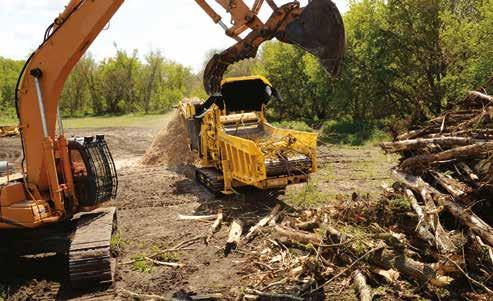

If you need assistance, please contact us on (02) 9264 0011. AA
Brian Beecroft Chief Executive OfficerVictoria’s wood and fibre producers welcome and support the world leaders’ pledge on halting deforestation by 2030 at the Glasgow Climate Change Summit, COP26.
Victorian Forest Products Association (VFPA) CEO Deb Kerr said our forests are the world’s lungs and need to be sustainably managed.
“While we commend the world leaders for their commitment, we need to make one thing clear: forestry does not equal deforestation. In Australia, forestry is well managed and sustainable and will continue to produce vital native timber furniture and other appearance grade products, along with wood fibre and paper and pulp products that we all depend on,” Ms Kerr said.
According to the Food & Agriculture Organisation (FAO) deforestation is the long term or permanent conversion of forests to other land uses and excludes regeneration where trees have been harvested. In Australia, all areas of native forests harvested are regenerated to ensure there is no net loss over time. In simple terms, every Victorian tree used for wood and fibre products is replaced and regenerated over time.
Many believe sustainable forestry is an oxymoron. But the UN’s very own Intergovernmental Panel on Climate Change (IPCC) has recognised it as one of the best ways to reduce carbon emissions:
“A sustainable forest management strategy aimed at maintaining or increasing forest carbon stocks, while producing an annual sustained yield of

timber, fibre or energy from the forest, will generate the largest sustained mitigation benefit.” – IPCC 4th Assessment

“Yet the Victorian Government will be responsible for pushing Australian demand for hardwoods offshore and, in some places, contribute to more deforestation.
“This is at odds with our nation’s commitment to the Deforestation Pledge. Already furniture makers in WA are seeking alternate supplies to Jarrah from Indonesian rainforest timber because local options will not be available for much longer.”
“If Australia is serious about ending deforestation globally, we must increase our timber resources by expanding our native and plantation forest estates,” Ms Kerr concluded.
For information visit www.vfpa.com.au
Customer satisfaction is our #1 goal. Adam from Ideal Tree Services is a testament to that. Adam has been using Bandit machinery since 1992 and over the years, we’ve supported him not only with great machinery, but also exceptional customer service. “We’ve had a massive association with Bandit,” says Adam. “The service is a big thing for me. I’ve had a great relationship with Mark and Sue, plus Terry is great and the guys in the workshop are fantastic.” Adam loves the Bandit product as the machine’s outstanding reliability and efficiency on site adds value and profitability to his business. “Overall the Bandit machines are pretty bullet-proof, I don’t think I’ve had one major issue in the whole time I’ve had the machines,” says Adam. Customers like Adam are the reason why we love what we do at Bandit. Our goal is simple. To ensure you have an outstanding experience with your Bandit chipper every day. We’re here to support your success. Welcome to the Bandit Family.

NSW/ACT
681 733